The high cost of dollar stores on low-income neighborhoods

Limited retail options on the South and West sides add to ongoing economic distress I PAGE 15


Limited retail options on the South and West sides add to ongoing economic distress I PAGE 15
Roz Brewer’s departure as CEO of Walgreens Boots Alliance comes in the midst of a multibillion-dollar e ort to stand up a new heath care business that has so far paid few dividends.


e Deer eld-based pharmacy giant announced Sept. 1 that Brewer stepped down from her role after less than three years — a period in which the company’s stock price lost more than half its value. In Brewer’s place, Walgreens lead independent board director Ginger Graham — an executive with the health care experience that Brewer, a veteran of Starbucks and Sam’s Club, lacked — will serve as interim CEO.
Brewer, 61, took over the company in 2021 as it embarked on an e ort to transition away from its core retail pharmacy business and leap head- rst into the complex and crowded health care

provider market. Like its peers and other retail companies — from CVS Health to Walmart and Amazon — Walgreens has attempted to make money in health care delivery as its traditional retail pharmacy business has come under pressure from e-commerce players and pharmacy industry entrants.
Walgreens has invested billions into acquiring health care assets, from primary care to specialty pharmacy services, many of which were executed under Brewer’s tenure. But the strategy has yet to excite investors as the segment is growing slower than anticipated. Industry analysts say it might still be too early to determine the strategy’s success or failure, but Brewer’s departure signals that Walgreens recognizes it’s time to kick-start the segment into growth and is hoping

A group of lawmakers, transit of cials and civic leaders has drafted a ‘bold’ outline of proposed changes for the region’s transportation system
By Greg HinzWith a looming nancial cli threatening to force cuts by as much as 40% in Chicago-area public transit service, voters are getting their rst look at a plan that’s spent months in development on how to remake the Chicago Transit Authority, Metra and Pace for the post-COVID era.
e plan is, to use its own word, “bold” — calling for new investments and fare cuts funded by expanding the state sales tax to cover more services and raising tolls on the Illinois Tollway, a shift of service away from its current downtown focus and the addition of more service, particularly on buses.
At the heart of the plan is what
amounts to a proposed massive regional deal in which City Hall would have to give up control of the Chicago Transit Authority, but in exchange get lots more money and relief from a current funding formula that the CTA argues has particularly worked against the interests of its riders.
Skeptics who said a retail veteran might not be the right kind of executive to lead a drive into the sector are vindicated as Brewer exitsGEOFFREY BLACK
For good or bad, the way of the world is that nothing lasts forever. Even political columnists, though we’re a long-lived breed. So below are some thoughts as, after an amazing half-century of watching Illinois politics and government, I dial way back on my tasks here at Crain’s.
Much as a few internet trolls would prefer, I won’t be disappearing. You can still call me a raging progressive, or a MAGA-loving Republican. I’ll still do a monthly column here, as well as an occasional special project. But this is a good time to take stock.
Let’s start with the pols — who, despite speculation to the contrary,
I really don’t hate. I nd politicians and government leaders in general to be no better or worse than the rest of humanity. eir egos may need regular stroking — an o ense that surely applies to journalists — but most are just people trying to do their job and look out for their future.
ere have been some real stars I’ve covered in government. e late U.S. Sen. Paul Simon and former President Barack Obama both went into this business for the right reasons, and both succeeded. Ditto for ex-Gov. Jim Edgar, a moderate conservative who knew and knows how to reach out. Close behind are ex-Mayors Richard M. Daley and Rahm Emanuel, who despite their mistakes had a vision for Chicago that made sense. And, reaching back a little further, former Mayor Harold Washington, whose death came when he was just nally
getting a chance to live up to his potential.
None of these folks were perfect. Edgar, for instance, bequeathed the state a backloaded pension system that decades later is still out of whack. Obama ignored the Democratic Party to focus on his own policy ideas, a mistake he paid dearly for during most of his tenure. Emanuel mishandled the Laquan McDonald tragedy. But all of them knew what they wanted to do and had a plan to do it, and — refreshing for Chicago politics — none were out to enrich themselves.
at said, local politicians still are too inclined to take care of their supporters — “the base,” in political parlance. at’s why Mayor Brandon Johnson’s treatment of the Chicago Teachers Union and its wish list will receive huge attention in coming months, because the mayor does not yet appear to realize
that what’s good for the CTU is not synonymous with what’s good for Chicago.
at split — taking care of the base — has worsened nationally. A visibly aged President Joe Biden has tried to hold together a center of sorts. But on issues such as abortion, gun control, LGBTQ rights, immigration and more, consensus seems increasingly out of reach. e cultural wars are back, with a vengeance. e mantra no longer is to come together and govern for everyone after the election. Instead, it’s take over and ram through what we want.
at is a recipe for civil war, not one nation.
A few thoughts for my media colleagues: Remember who your writing and reporting is really for: your readers and subscribers, people who count on you to inform them. Be passionate; if you check
out at 5 o’clock and don’t go the extra mile, your readers will be shortchanged. In other words, it’s personal. Treat public o cials and candidates with respect, but insist that you be treated with respect because you’re doing a job that, in a democracy, needs to be done.
More thoughts for the media: Keep it light and entertaining; your clients, your readers, don’t want to be lectured or ooded with minutia. Above all, tell the truth. at means reaching out to make sure your perspective is complete. In other words, progressives, try to understand why many millions of voters like Donald Trump. Truth-telling may mean burning a source or inviting retaliation. So be it. As a wise colleague once told me, if at any point in time at least a couple of pols don’t want to hang you by your toes, you’re not doing your job. See y’all a little later.
The walk from the Roosevelt Road el station to Soldier Field on game day o ers a lesson in numerical history, with Bears jerseys as the study guides.
Justin Fields (No. 1) is gaining on Walter Payton (No. 34) as the garment of choice. Sturdy linebacker mates Brian Urlacher (No. 54) and Lance Briggs (No. 55) still claim a following, as does Dick Butkus (No. 51) among us gnarly old-timers.
You half expect to see a Devin Hester acolyte (No. 23) darting in and out among fellow pedestrians, while Matt Forte (No. 22) is content to bob along behind his blockers and take what the tra c gives him.
It didn’t end well for Brandon Marshall here, but don’t remind the tall, trim target sporting the No. 15 Marshall jersey.
But No. 6, oddly, is nowhere to be found. Belonged to a fella named Cutler.
Butkus and Payton aside, each of the aforementioned luminaries has played for the Bears since I moved back to Chicago for the 1997 season. I’d spent 20 years in northern California, and I was spoiled. I had seen the 49ers revolutionize pro football under Bill Walsh. e Bears are still searching for their equivalent genius.
My rst year back was Dave Wannstedt’s next-to-last as coach.
en came Dick Jauron, Lovie Smith, Marc Trestman, John Fox
Correction
and Matt Nagy. Front o ce folks included Mark Hatley, Jerry Angelo, Phil Emery and Ryan Pace.
A lot of names, a fair amount of talent and not a lot of success. And now, Year Two of Matt Eber us and Ryan Poles.
A 100% improvement in the record gets them to six wins, which gets them nowhere. ey’ve brought in a big-play receiver.
ey’ve upgraded the roster. ey believe they’re building something on defense.
But it’s the NFL. It all comes down to Mr. Fields. If you haven’t got the quarterback right, you haven’t got anything.
e best thing the Bears might have going for them is that the division has come back to them.
Green Bay pretty much ruled it during the Favre/Rogers era, but the Packers are in for a serious retrenchment. If the carefully sheltered Jordan Love somehow maintains the standard to which the Packers are accustomed, he’ll be the NFL’s biggest stunner since Kurt Warner became a Super Bowl quarterback for the Rams.
Detroit is the avor of the month in the NFC North going in, but given their grim history — one playo victory since 1957 — the Lions will always be the Lions until they prove otherwise.
Meanwhile, some questionable salary cap decisions depleted the Vikings’ roster, and they’re still trying to win with a quarterback who hasn’t won anything of note.
So, coming o a dismal, the division is there for the Bears. Are they good enough to take it?
Not yet. e ask is too much.
Yet I remove my reporter’s
objectivity cap and hold out hope. My day job is at Leo High School, a small, all-boys, all-minority Catholic school on Chicago’s South Side. Eber us came for a visit last spring. During an assembly, he talked about resiliency, about setting goals and sticking to them, about getting up after you’re knocked down. He answered questions, posed for pictures . . . he could not have been more gracious.
Our guys come from some hardscrabble backgrounds. It meant something to have the head coach of the Chicago Bears share his time with them.
During training camp, several young Leo men attended “Scout School” at Halas Hall. ey watched practice with the scouts and listened in on their conversations. After lunch, representatives of various departments shared their stories of how they’d come to work in pro football, in keeping with Poles’ objective of showing the kids that a career in sports is possible without being an elite athlete. ey were . . . dazzled.
Some context: Wannstedt probably bought himself an extra year as Bears coach by being a good guy. But it’s a results-oriented game,
and if the results aren’t there for Poles and Eber us, character and kindness aren’t going to save them. Or maybe they’ll turn out to have a little Jimmy Johnson in them. Jimmy cut, among others, his wife after taking over the Dallas Cowboys. He proceeded to win two Super Bowls and a ton of games . . . without ever being accused of being a nice guy. Whatever works.
Crain’s contributing columnist Dan McGrath is president of Leo High School in Chicago and a former Chicago Tribune sports editor.

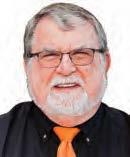
Construction of the $800 million museum campus is about halfway done and due to be completed by fall 2025
IIt’s still far too early to tell whether it indeed will be a transformative project, one that will raise Chicago’s pro le and change the direction of a big chunk of the South Side for better — or, according to a few critics, for worse.

But after years of planning and raising well over $1 billion, the Obama Presidential Center nally has emerged from the ground as a physical presence in Jackson Park, just across the street from Hyde Park Academy High School and a quick walk from the University of Chicago campus.
Cement trucks roar around the 19.3-acre site and workers — 53% of them minority, according to the center — scurry about.
The mayor has promised to not raise property taxes, a move that could box him in on making investments toward a more equitable Chicago
Mayor Brandon Johnson has about a month to decide whether to hold rm on a campaign pledge to not raise property taxes, a decision that will shape his rst budget and ability to make sweeping investments he says are needed to make Chicago more equitable.

Johnson is tentatively scheduled to release his rst budget proposal on Oct. 11 and has given no indication he’ll ip- op on raising property taxes. But absent other sources of revenue that are unlikely to materialize this year, his rst spending plan will be measured on the down payments it lays down, rather than “transformative investments,” according to his allies in the City Council.
But those allies say setting the foundation for how Johnson will govern through his rst budget is enough to keep their support and convince the broader movement that elected him that it was worth the e ort.
By Greg HinzThe center’s central tower, which will house a digital presidential library and museum, is now several stories in the air and set to be topped off by April.

Johnson has already scaled back his campaign rhetoric to match the governing reality on a number of important initiatives, including reopening the city’s shuttered mental health clinics over time, instead of during his rst year in o ce, and tweaking a real estate transfer tax to a tiered rate, rather than hitting all sales that eclipse $1 million.
A clearer picture of where the mayor’s budget is heading will emerge after the city releases its annual forecast later this month, which will provide more clarity
on whether 2023 revenues continue to outpace previous estimates and the anticipated budget de cit for 2024.
In April, just before handing o the reins to Johnson, former Mayor Lori Lightfoot released a released a midyear budget forecast that projected a 2024 budget shortfall of just $85 million, down from a previous estimate released last summer that set the gap at $473.8 million.
But the forecast relied on keeping in place a Lightfoot-era initiative to annually raise the city’s property taxes based on the yearly rise in the consumer price
The Chinese American Service League paid $8 million for a 5.2-acre property in Bridgeport, where it intends to build a mixed-use project
Danny EckerA long-vacant development site along the western edge of Bridgeport is poised to become a mixed-use campus serving the city’s growing Asian American population after it was sold to a locally based social service agency.
e Chinese American Service League paid $8 million late last month for the 5.2-acre property at 3000-3052 S. Pitney Court, according to a statement from ACO
Commercial, which marketed the property on behalf of the seller. e Chicago-based nonpro t plans to develop the site with a “comprehensive community care campus” that includes affordable senior housing, an adult day service center for seniors, an early child-care center and a commercial kitchen for senior meals and culinary training programs, the statement said.
e project, which would be built along the arm of the Chicago River’s south branch known
as Bubbly Creek, is slated to include a community center that o ers sports programs, meeting space and outdoor garden space along the water.
e plan would bring activity to a long-fallow property that was home to a Peoples Gas manufactured gas plant over a century ago and has undergone extensive environmental remediation over the past 15 years. It would also highlight the continued
A clearer picture of where the mayor’s budget is heading will emerge after the city releases its annual forecast later this month.FILEPHOTO The development site at 3000-3052 S. Pitney Court in Bridgeport. I ACO COMMERCIAL
An association representing more than 120 corporations, including high-pro le locally based heavyweights like drugmaker AbbVie and agribusiness giant Archer Daniels Midland, has asked state regulators to overturn a Commonwealth Edison surcharge that they say is collectively costing them more than $100 million.
e Aug. 31 ling by the Chemical Industry Council of Illinois, along with several other individual companies and other institutional power consumers, takes aim at ComEd’s monthly charge gradually clawing back credits the utility provided customers last year and early this year under the Climate & Equitable Jobs Act, or CEJA.
ose credits, which turned out to be wildly and overly generous, were tied to payments under the 2021 clean-energy law that nuclear power generator Constellation Energy Group made to ComEd under provisions to bail out three nukes in Illinois. e law set a power price those facilities were to get from ComEd customers over a ve-year period.
Under CEJA, if market prices turn out higher than the bailout price, Constellation is to refund the di erence, and ComEd customers get a credit on their bill. If
lower, ComEd pays Constellation the di erence and sends the bill to customers.
Customer arguments
ComEd ended up refunding $1.1 billion more than it should have in the year that began June 1, 2022. Beginning in June 2023, it now is recovering that amount and charging 5% interest to do so.
e industrial customers argue that the Illinois Commerce Commission didn’t follow CEJA in allowing ComEd to impose the surcharge without conducting a formal proceeding. e ICC voted instead in May to allow the surcharge to go forward without a review that would permit the involvement of outside parties.
ey also argue that ComEd’s alleged mismanagement of the program should bar the utility from collecting the surcharge.
ey’re urging the commission to halt it and order refunds of what ComEd has collected since June.
“ e Chemical Industry Council of Illinois is ling this complaint because our members are being whipsawed by the huge increase in ComEd Carbon Free Resource Adjustment charges, which began in June 2023,” council CEO Mark Biel said in a release.
“We are convinced that these charges are unjusti ed and should be disallowed by the Illinois Commerce Commission.”
A lawyer for the complainants cited ComEd’s admissions of bribery over nearly 10 years in calling on the utility to allow for a more open debate over how it’s managed the CEJA nuke bailout charges and credits.
“After its July 2020 Deferred Prosecution Agreement and ComEd’s alleged rededication to fully transparent and ethical management, it’s more than disappointing to see ComEd take back credits it had provided to customers without justifying its actions,” attorney Paul Neilan said in the release. In representing the plainti s, Neilan is joined by Patrick Giordano, a longtime attorney on utility issues who’s represented large users unhappy with ComEd’s actions in the past, such as the building formerly known as the Sears Tower.
In their complaint, the parties allege that the massive size of the clawback — $1.1 billion — was revealed in a Securities & Exchange Commission ling by ComEd parent Exelon only after the ICC moved to allow it without a formal proceeding.
“Since the commission did not suspend what appeared to be innocuous revisions to the Rider CFRA tari s, no hearings were held regarding the propriety of these tari revisions,” according to the complaint. “As a result of ComEd’s lack of disclosure of the
real nature of its lings of these tari revisions with the Commission, no party had an opportunity to object to the massive impacts of ComEd’s revisions to Rider CFRA before the revisions went into effect.”
Increase about 8%
ComEd currently is adding a charge equaling more than a penny per kilowatt-hour to customer bills to claw back the credits. at is about an 8% increase to electricity bills each month.
ComEd spokeswoman Shannon Breymaier said in an email that the utility was analyzing the complaint. But, she wrote, ComEd “expects to vigorously defend our actions in implementing CMCs.”
“We are appropriately charging and crediting customers and have been clear about the CMCs, and the charges and credits that implement them, with the commission and our customers,” she said.
e commission will have to respond to the complaint and is likely to get a motion to dismiss from ComEd. Commission Chairman Doug Scott joined the agency in June, about a month after its initial decision to allow the surcharges to go forward. He was a key architect of CEJA as an adviser to Gov. J.B. Pritzker in 2021, when the law was passed, and the way the nuclear bailout was structured was a point of pride for the Pritzker team.
It appeared to work better than anyone might have imagined when market power prices soared in 2022 after Russia’s invasion of Ukraine. But prices de ated within months while the ComEd credits to customers remained, causing the imbalance that led to the $1.1 billion recovery.
Whatever the commission does, the issue is likely headed to the Illinois Appellate Court, which hears appeals of ICC rulings.
being covered by insurers.
Facing multiple shareholder lawsuits tied to the ComEd bribery scandal, Exelon wants to use insurance proceeds for one settlement to defray insurance costs tied to another one.
Exelon has proposed to settle a series of shareholder suits brought against directors and ofcers on behalf of the company for $40 million. Plainti s’ attorneys would get $10 million of that under the proposal.
e remaining $30 million would go to fund part of a $173 million settlement that Exelon has entered into with shareholders who sued the company to compensate them for stock losses they said they su ered after Exelon-owned Commonwealth Edison admitted to a nearly decadelong scheme to bribe then-Illinois House Speaker Mi-
chael Madigan.
“As explained in court, the terms of the derivative settlement did not dictate how the settlement proceeds are to be used,” Exelon spokeswoman Rhea Marshall said in an email. “Exelon determined that it is in the company’s best interest to use the proceeds from the derivative settlement — net of attorneys’ fees — to fund a portion of the securities settlement.”
An outside attorney for Exelon disclosed the plans for the cash during a hearing Aug. 31 in federal court in Chicago. A group of plainti s seeking damages on behalf of the company have challenged Exelon’s proposed settlement, asking, among other things, if there’s more insurance coverage available to settle the litigation than what Exelon so far has disclosed.
Exelon thus far hasn’t been willing to say, plainti s’ attorneys
say. e company declined to disclose the gure to Crain’s.
e objecting plainti s want U.S. District Judge John Blakey, who’s overseeing the litigation, to force Exelon to disclose that gure. He has yet to rule on that and other objections.
Both settlements are pending court approval, but the $173 million one gures to go forward, since none of the parties is opposing it.
e $40 million settlement is a di erent story. at’s the culmination of a two-year process in which Exelon appointed a special committee made up of three outside lawyers to negotiate with the plainti s’ attorneys. e committee, and Exelon’s board itself, agreed to settle the suit in May, and the panel issued a 100-page report in June summarizing its work.
er to gather information from the special committee on how it reached its decision.
Attorneys representing the special committee argue that Pennsylvania state law, under which the case is being considered, provides such panels wide latitude on settlement terms if their members are independent and their probe adheres to reasonable standards.
When it rst disclosed the two settlements in May, Exelon looked to be committing to pay $213 million between the two. With $30 million from one going toward the other, the actual gure is $183 million. All of that is
Some plainti s have cried foul, saying a separate group of plainti s who signed onto the settlement came into the process just a few weeks before the deal was nalized.
ey’re challenging it in court and asking Blakey for more pow-
In court, a lawyer for the objecting plainti s also questioned why the only individual executive made to pay personally in the settlement is former Exelon CEO Chris Crane. Crane had performance shares he was set to collect reduced by $4.2 million earlier this year. He still saw his compensation for 2022 total more than $30 million, with $11 million of that made up of stock awards.
ComEd paid a $200 million ne in its 2020 deferred-prosecution agreement with the U.S. attorney’s o ce in Chicago. at was not covered by insurance.

Exelon has proposed to settle for $40 million a series of shareholder suits brought against directors and of cers on behalf of the company.



















Fisher-Harrell, 53, a former dancer with Hubbard Street Dance Chicago, is the rst woman and rst person of color to be the company’s artistic director. Earlier this year, she signed internationally renowned Canadian-American choreographer Aszure Barton as a resident artist for three years at the contemporary dance company. She and her husband live in Uptown and have three children, ages 31, 29 and 15. I

Tell us about your early years. My childhood was unique because both of my parents were blind. My dad has no vision, and my mom has just a little, enough to cook and take care of us. We had a very middle-class lifestyle in Baltimore’s inner city.
How did that affect you?
I grew up fast. Helping my parents get around was just part of being. We always took the bus, and at 3 years old, I already knew enough letters to help my mom identify stops. By age 9, I was catching the bus by myself.
Why did you become a dancer?
I came to dance at an exciting time, in the ’80s. Michael Jackson was ghting to get on MTV. Movies like “Flashdance” and “Fame” were hot, and the TV series “Solid Gold” was super popular. I dreamed of being in an M.J. video.
How did you break into that world?
rough pure ignorance. At 14, with zero dance training, I auditioned for the Baltimore School of the Arts and was accepted.
What did they see in you?
I was exible, musical and I could move. I imagined them thinking, “She’s (dancing) all wrong, but she’s strong and wrong, and could be taught.”
A major hurdle?
Getting into dance so late. Unlike younger kids, I had to learn ballet, modern, jazz and West African technique all at the same time.
A pivotal moment?

At age 14, I went to a performance of the Alvin Ailey American Dance eater (a primarily African-American, New York-based modern dance company) and it kicked my training into high gear. I could identify with the people onstage. So long, Michael Jackson video. I had a new dream.
How did that turn out?
At 19, I joined Hubbard Street for three years, and then became a principal dancer at Alvin Ailey, which took me around the world.
Most memorable audience?
President George W. Bush and
By Laura Bianchithe rst lady, Colin Powell, Condoleezza Rice and Dick Cheney. It was mind-blowing! I was one of three Alvin Ailey dancers invited to perform at a White House state dinner.
What would surprise us about you?
Before I started dancing, I dreamed of being a Marine. Seriously.
Why?
e powerful precision of the Silent Drill platoons that I saw on TV, with Marines in dress uniform and white gloves with ri es or swords, was inspiring.
Why didn’t you enlist?
I realized that I was drawn to the choreographed movements, not the battle eld.

The legislative effort to gradually eliminate Chicago’s sub-minimum wage for tipped workers is back on track and teed up for approval as soon as early October after a key committee vote last week.
Introduced in July, the ordinance would phase out the city’s lower wage for tipped workers over a two-year period. The measure has the backing of Mayor Brandon Johnson and has been pushed by the national One Fair Wage campaign.
But at the July meeting, Ald. Anthony Beale, 9th, put up a temporary roadblock by sending the ordinance to the Rules Committee, a move that slowed down the process and gave the restaurant industry more time to galvanize opposition to the measure.
In a procedural voice vote Wednesday without significant opposition, the Rules Committee, which includes the entire City Council, voted to send the
measure back to the Workforce Development Committee. If the full City Council approves the same action at its meeting Sept. 13, a final vote on the ordinance would likely be set for the Oct. 4 City Council meeting.


Before a final council vote, the Workforce Development Committee would need to approve the proposal. Freshman Ald. Jessie Fuentes, 26th, who introduced the ordinance along with Johnson’s City Council floor leader, Ald. Carlos Ramirez-Rosa, 35th, said a vote by that committee would be scheduled for later this month.

The proposal would require the sub-minimum wage to be increased by about $3 by July 2024 and another $3 in July 2025 to match the city’s standard minimum wage, which is $15.80 for companies with at least 21 employees and $15 for smaller companies, with annual cost-of-living increases thereafter.
Currently, employers are on the hook to make up the difference when an employee’s hourly wage plus tips don’t add up to the city’s minimum wage. Even if the sub-minimum wage is approved, workers could still receive tips to boost their wages further.

The proposal is opposed by the Illinois Restaurant Association, which successfully fought a similar effort in 2019 by former Mayor Lori Lightfoot, who settled for a one-time bump in the sub-minimum wage without a path to eliminate it.
Sam Toia, president of the association, has argued that the two-year phaseout period is too short and will put a strain on restaurant owners who operate on thin margins.

Fuentes previously told reporters her coalition was open to a four-year phaseout, but the ordinance has not been amended.
“We have not been closed to negotiations or further conversations with folks like Sam Toia and the Illinois Restaurant As-
sociation,” Fuentes said after the meeting. “He knows how to get a hold of us and we will reach out.”

In previous negotiations, opponents of the measure, including large restaurant groups, have also offered a potential compromise where restaurants could opt to either agree to phase out the tipped wage or pay their workers a minimum
wage of at least $20, according to two sources familiar with the discussions, but that option has been shot down by the supporters of the ordinance.
“We shouldn’t have to invent systems to get people to a fair wage,” Fuentes said when asked about the floated compromise.
As they have during each step of the legislative process, supporters of the ordinance held a rally at City Hall after the Sept. 6 vote.



Atwo-level penthouse in the earliest downtown high-rise built expressly for condos is for sale by its owners of almost two decades.
Along with its spot in downtown real estate history, the condo has a feature that shows o its early-1960s pizzazz: a two-story wall of windows shaped like a barn because of the zigzag of the roo ine. It frames a nice view of surrounding buildings and Lake Michigan.
Priced at $588,000, the two-bedroom condo is one of four original penthouse units at 201 E. Chestnut St. Construction began on the 26-story Gold Coast tower in 1964, months after Illinois legislators passed a law in July 1963 making condominium-style ownership within multi-unit buildings possible.

By early 1965, the developer, Dunbar Homes, was touting the project with ads in the Chicago Tribune as “Chicago’s rst closein condominium,” which distinguished it from a contemporaneous building on Barry Avenue in Lakeview.
Dunbar, headed by Herb Rosenthal, had already completed the city’s rst new condos, as opposed to conversions of existing units, in a low-rise development at 6347 N. Ridge Ave. at the northwest corner of the Edgewater neighborhood.
At the Chestnut Street building, Dunbar’s ads promised “everything that spells urbane elegance, in the shadow of Chicago’s historic Water Tower, with the security of home ownership.”
e architect for the tower, Richard Barancik of Barancik & Conte, died earlier this summer, leaving behind a large portfolio of modern residential towers, bowling centers and other structures, including the zippy rolling roofs of two long-vacant bathhouses at Adeline Jay Geo-Karis Illinois Beach State Park.
Before his death, Barancik was the last surviving member of the Monuments Men, an international military group in World
War II that protected and recovered European artworks looted by Nazi soldiers.
On Chestnut Street, Barancik designed a 124-unit building with four duplex penthouses at the top, beneath a pyramidal cap that covered the “skyline lounge” common area and swimming pool. e roo ine over the penthouses bends up, over and back down several times to give each of the penthouses a 17-foot wall of windows in the gambrel shape, which resembles a barn.
e penthouse that’s on the market, represented by Compass agents Santiago Valdez and Elizabeth Pyle, has a river rock replace that the agents believe is original to the design, because another penthouse that sold several years ago has the same.


e condo, which has been on and o the market since June 2020, “needs some updating,” Pyle said. e kitchen and two baths are dated, but livable. It has one bedroom on the rst level with the living room, kitchen and balcony, and a second bedroom and open loft room on the upper level.
e sellers bought the condo in 2005 for $575,000, according to the Cook County Clerk’s O ce. At the present listing price, $588,000, they’re asking 2% more than they paid for it. ey originally listed it at $649,000 two years ago.
By Dennis RodkinMost insurers will cover only 30 one-hour therapy sessions — for an entire calendar year.
Dan and Jennifer Gilbert last week announced the Gilbert Family Foundation, Henry Ford Health and Shirley Ryan AbilityLab will bring a 72-bed state-ofthe-art physical medicine and rehabilitation facility and neurobromatosis research center to Detroit.
e rehab facility will become part of Henry Ford Health’s campus expansion and be managed by Shirley Ryan AbilityLab of Chicago.
e Nick Gilbert Neuro bromatosis Research Institute will be created in partnership with Henry Ford Health and Michigan State University Health Sciences.
e construction and operation of the initiatives will cost an estimated $439 million over 10 years, according to a news release. e Gilbert Family Foundation will contribute nearly $375 million in grant funding.
e neuro bromatosis institute is named after the Gilberts’ late son to house research advancing toward a cure for NF and increasing access to personalized
care. Nick Gilbert died in May after a lifelong battle with the genetic condition.
Dan Gilbert su ered a stroke in May 2019 and underwent treatment at the Shirley Ryan facility in Chicago.

“When I su ered my stroke back in 2019, I sought out the best care in the country and found it in Chicago with the Shirley Ryan AbilityLab,” Gilbert said Sept. 6. “I’m forever grateful to the doctors, nurses, therapists and sta who helped me improve every day. However, while there I met many other patients who could not get all the rehabilitative care they need because insurance limited the number of hours covered. is is too often the experience for Detroiters as well.”
$10 million fund
To that end, the Gilbert Family Foundation is establishing a $10 million fund speci cally for Detroit residents who make less than 400% of the federal poverty line to receive care at the new stroke center. It’s unclear how many patients will ultimately bene t from that fund, but Peggy
Kirk, president and CEO of AbilityLab, said she expects it to be “a lot of patients.”
e planned AbilityLab in Detroit — slated to open in 2029 — will occupy three oors of the planned Henry Ford Hospital tower and will total 125,000 square feet.
e Shirley Ryan AbilityLab has been ranked by U.S. News and World Report as the highest-ranking rehab hospital in the country.
“Our singular focus is helping patients regain ability through intensive rehabilitation that leverages the best tools and technology,” Kirk said. “ at really enhances their ability to function, to move, to communicate and participate in a meaningful life.”
A facility such as the planned AbilityLab has been discussed as needed in Detroit for some years, as Crain’s Detroit Business has previously reported.
“Normal insurance doesn’t pay for the rehabilitation” of a stroke at the level that Dan Gilbert was able to pay for, Phil Weaver, CEO of Hope Network in Grand Rapids, told Crain’s in early 2020.
“For a person with a serious stroke, or even a mild stroke, to be frank, it doesn’t move the needle far enough,” Weaver said at the time of the covered one-hour sessions.
While AbilityLab has its agship location in Chicago, the organization has partnerships around the world, Kirk said. However, the planned Detroit facility will make for a “new, smaller agship,” Kirk said.
Bob Riney, president and CEO of Henry Ford Health, said the inclusion of the Shirley Ryan AbilityLab, as well as the Nick Gilbert Neuro bromatosis Research Institute, t in perfectly with the planned $2.5 billion planned expansion.
“I think that what you’re going to see with this campus is what Detroit needs, which is a worldclass destination for care for both people that live in the immediate ZIP code and people that live beyond,” Riney said. “And with the Shirley Ryan AbilityLab — and some of the critical clinical services that we’ll be doing — this will not only take care of our im-
mediate neighbors, but people will be coming from all over to seek this care. And that’s another economic multiplier for the city.”
e Sept. 6 announcement makes for the “most signi cant and ambitious philanthropic project” on which the Gilberts have embarked since the couple’s initial launch of a $500 million initiative in March 2021.
at funding comes from the Gilbert Family Foundation and the Rocket Community Fund, with $350 million from the former and $150 million from the latter — expected over the next 10 years, or $50 million annually, to be given to a variety of initiatives in the city.
Other uses for that money have been numerous, and include $13 million to ght eviction, $10 million to help fuel startup growth and another $10 million to help contractors in the city of Detroit.
e Gilberts’ philanthropic funding comes, at least in part, from a March 2021 $500 million sale of stock in Rocket Companies, the parent company of Rocket Mortgage, of which Dan Gilbert is board chair and the largest shareholder.
Nick Manes writes for Crain’s sister publication Crain’s Detroit Business.
No matter where you stand on the contentious issue of school choice — shorthand for the debate over using state money to help families defray the cost of private schools — most fair-minded people can agree on this: Vociferous opponents of school choice should probably live by the rules they would enforce on others.
And yet, it’s come to light that one of the harshest critics of school choice in Chicago — who has gone so far as to characterize those on the opposite side of the debate as racists — is sending one of her children to a private school. Decrying the quality of the public schools available to her family on the South Side, she explained that this private school better matches her ambitious and talented child’s academic, social, emotional and extracurricular needs.
She is, surprisingly enough, Stacy Davis Gates, president of the Chicago Teachers Union, who, along with her rank-and-file membership of roughly 25,000 Chicago Public Schools employees, has successfully campaigned against measures that would divert public money to help families afford private school — families, we might say, just like hers.

In justifying her decision to send her son to a Catholic high school on the South Side, Davis Gates noted that “options for Black students, their families and entire Black communities on this city’s South and West sides are limited,” and cited disinvestment in
How will the CTU rank and le — not to mention the Chicago Board of Education — feel about Davis Gates’ critique of the quality of their work product in Chicago?
schools in those swaths of the city. And yet, in 2013, the school district’s total budget was $5.3 billion, or about $13,200 for each of its 403,000 students. The 2023 budget is $9.4 billion, or about $29,400 each for the current enrollment of roughly 322,000 stu -
dents.
Which isn’t to say school funding isn’t in crisis in Chicago. Far from it. About $4,000 of the CPS budget per student is used to pay for non-academic expenses such as pension payments and debt financing. And, as fed -
eral COVID money runs out, deficits loom. Meanwhile, personnel costs make up the lion’s share of CPS expenses at 65%, and its 43,000 employees get raises every year — thanks in part to a new contract signed after Davis Gates & Co. walked off the job for 14 days in October 2019, winning a 16% salary increase over the coming five years.
To be sure, Davis Gates isn’t getting state support to pay for her son’s private school education. Presumably, she and her family can afford to pay tuition in the range of $15,000 a year. But what about other parents on the South and West sides who might want to send their children to a private school for the same reasons Davis Gates did — but aren’t in the position to pay a tab of that size? Are they fascists and racists, as Davis Gates herself once characterized advocates of school choice?
As long as we’re asking questions, here are a few more: How will the CTU rank and le — not to mention the Chicago Board of Education — feel about Davis Gates’ critique of the quality of their work product in Chicago?
In a Sept. 7 letter to her membership sent in the wake of the news, she cast her team as the heroes who have “always fought and will continue fighting for the equitable resources that these school communities deserve.” As for the Board of Ed, the jury is still out: As of this writing, President Jianan Shi has not returned Crain’s calls seeking comment.
We are now a few weeks removed from the release of the Illinois Auditor General’s scathing performance audit of the Illinois Department of Employment Security Unemployment Insurance Program. is audit revealed that due to gross incompetence and mismanagement by IDES, the state of Illinois lost more than $5 billion in wrongful unemployment payouts, including massive fraud, between March 2020 and September 2021.
While IDES and its apologists will argue that every state dealt with fraudulent claims during the COVID-19 pandemic, they are ignoring the ndings of the audit,
which clearly show IDES made several poor key decisions that exacerbated the fraud problem. For example, IDES disabled routine identity cross-matches — speci cally designed to prevent fraud — in its undisciplined scramble to rush claims out the door.
is conscious decision to pay claims at a reckless speed helped lead to the eye-popping $5 billion in fraud, which included more than 10,000 payments to deceased people and more than 90,000 payments to incarcerated people.
Additionally, the report showed that IDES chose not to implement additional cross-matches that the
U.S. Department of Labor introduced in October 2021, and in fact still wasn’t utilizing this free resource as of February 2022.
If that wasn’t enough, the audit hammered IDES for being ill-prepared to handle an in ux of unemployment claims prior to the pandemic. One of the report’s key recommendations is for IDES to establish a “recession plan” for “future reference in times of rapidly increasing claim volumes.” I would argue that being prepared for a potential recession or any catastrophic event that leads to a high volume of claims is an essential responsibility of the agency that shouldn’t require recommendation from the state’s Auditor General. How is it possible they were so unprepared?
Overall, this lack of planning left qualied and deserving unemployment claim-
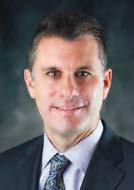
ants to face substantial delays in receiving their payments. I had constituents in my o ce in tears because their valid unemployment claims were not being paid, and IDES was unreachable and would not return their calls.
Democratic lawmakers chose to prioritize funding pet projects with federal pandemic relief funds instead of using this one-time federal windfall to pay o that debt in a timely manner like nearly every other state did. e federal government included a deadline of November 2022 for states to x their unemployment trust fund debts, or they would lose the Federal Unemployment Tax Act, or FUTA, credit in 2023.
When this deadline was missed, Demo-
11
Roughly two months after the unexpected death of Henry Crown & Co. CEO Jim Crown in June, the public safety task force he headed at the Civic Committee of the Commercial Club of Chicago has named two executives to lead the e ort to draft a set of business-backed crime- ghting recommendations.
Mark Hoplamazian, CEO of Hyatt Hotels, and Eric Smith, vice chairman of BMO Bank, are the new co-chairs of the task force, the Civic Committee announced on Sept. 8.
Hoplamazian, who co-chairs Hyatt’s

From Page 10
cratic lawmakers and the Pritzker administration nally decided to ll the unemployment insurance trust fund hole in late 2022, but it was too late to mitigate the impacts to businesses and their employees. Illinois employers have lost out in three signi cant ways: the FUTA credit is suspended for a year, a 2.5% increase in the taxable wage base has been implemented and employers are saddled with paying back a $450 million loan to the state.
Now that this audit makes it clear that the unemployment insurance trust fund de cit is almost entirely the fault of gross mismanagement of the state’s unemployment insurance program, the Pritzker administration needs to face the music. It must address the IDES negligence and make it right for our state’s employers.
Illinois businesses did not create the state lockdowns that put people out of work, nor are they at fault for the incompetence and fraud that led to overpayments. ey shouldn’t be expected to carry the burden of those mistakes, yet the Democrats and the Pritzker administration continue to place that heavy burden on job creators.
It is time for accountability for the devastation that was brought upon employers. While there is nothing the state can do now about the lost FUTA credit or the increased taxable wage base, it is still possible to forgive the $450 million that the state is requiring employers to pay back. is action should be taken immediately.
In July, the governor announced that the state has a “one-time” surplus of roughly $726 million. is announcement and this audit brought me back to the previous times I called for my fellow Illinois lawmakers to use unexpected revenue and federal relief funds to pay down the unemployment insurance trust fund debt, to no avail.
Just like those previous times, I once again call upon Gov. J.B. Pritzker and Illinois lawmakers to do what we know is right and stop making job creators pay for the state’s failures.
e state of Illinois owns this.
e state of Illinois should foot the bill.
Global Diversity, Equity and Inclusion Council, and Smith, who leads BMO’s Empower program designed to promote economic opportunity in underprivileged communities, take over leadership of the task force as it seeks to build community-level consensus and raise money for a plan rst unveiled in early June — just weeks before Crown, its main architect, died in a June 25 accident in Colorado.
Hoplamazian and Smith both served on the task force that developed the vepoint plan that includes a goal of cutting homicides by 75% over the next decade and slashing shootings by even more. To get there, the plan proposes a major ex-
pansion of violence intervention programs and investments in long-neglected neighborhoods.
“Our ve commitments re ect what business can bring to the table — a table that needs to be bolstered with leaders from across all sectors and work together and hold each other accountable,” Civic Committee President Derek Douglas said in an interview with Crain’s after the June 1 unveiling. He added, “We can and must support e ective, constitutional policing, while doing what we can to support those that put their lives on the line.”
In a joint statement, Hoplamazian and Smith said, “We are honored to build on
the legacy of Jim Crown, whose dedication to our City and the public safety task force was extraordinary. We reaffirm Jim’s vision that the business community has a significant role to play and are committed to building on his important work to help make Chicago the safest big city in America.”
Civic Committee Chair Jennifer Scanlon said in a written statement, “Mark and Eric have been key members of the Public Safety Task Force since its inception. ey are an ideal team to help ful ll the vision of a deeply engaged business community contributing to Chicago’s overall safety and well-being.”
I help you balance the two, with real-world, pragmatic, risk-aware guidance and advice.
I work with organizations and their in-house counsel, helping them stay current, compliant, and proactive through strong data governance strategies and programs.
Protecting their vital business data along with the customer and stakeholder data under their care. Creatively building and enhancing legal structures that support revenue-generating data use enabled by cutting-edge technologies.
Negotiating licensing, cloud, outsourcing, and IT agreements while preserving important relationships.
Spotting issues and developing creative solutions for managing the sheer volume of data, the rapidly evolving technology, The complex and varied global laws and regulations, and the increasingly sophisticated threats. The real world of data privacy and security can be gray and murky
I make it clearer. I also make it fun and rewarding.
I’m RYAN SULKIN
I’m on your team.
>
>
At the same time, data use and analytics present tremendous opportunity.
2022 RANKLAW FIRM LOCAL MANAGING PARTNER NO. OF LOCAL ATTORNEYS 6/30/ 2023; 1-YEAR CHANGE NO. OF U.S. ATTORNEYS 6/30/ 2023; WORLDWIDE LOCAL PARTNERS LOCAL ASSOCIATES LOCAL OF COUNSELS LOCAL PARALEGALS ANTITRUST BANKING BUSINESS REORG. & CREDIT CORPORATE & SECURITIES HEALTH CARE INSURANCE INTELLECTUAL PROPERTY LABOR LITIGATION ENVIRONMENTAL & LEGISLATIVE MUNICIPAL REAL ESTATE TAXATION 2022 FIRMWIDE REVENUE (MILLIONS); 1-YEAR CHANGE 20 19 NEAL GERBER & EISENBERGLLP 2 N. LaSalle St.,Suite 1700,Chicago 60602; 312-269-8000; NGE.com RobertG.Gerber Managing partner 131 -1.5% 21 21 REED SMITHLLP 10 S. Wacker Drive,40th Floor,Chicago 60606; 312-207-1000; ReedSmith.com JimHultquist Managing partner, Chicago o ce 128 -2.3% 1,109 1,828 5650191007172613181013315015$1,417.6 -1.3% 22 24 BARNES & THORNBURG 1 N. Wacker Drive,Suite 4400,Chicago 60606; 312-357-1313; BTLaw.com MichaelA.Carrillo Chicago o ce managing partner 126 3.3% 840 840 8231101853421893172210433 $608.8 1 5.8% 23 27 AMUNDSEN DAVISLLC 2 150 N. Michigan Ave.,Suite 3300, Chicago60601; 312-894-3200; AmundsenDavisLaw.com LarryA. Schechtman Managing partner 119 5.3% 240 240 6832990224109312612731— 23 24 PERKINS COIELLP 110 N. Wacker Drive,Floor 34,Chicago 60606; 312-324-8400; PerkinsCoie.com RichardL.Sevcik Chicago o ce managing partner 119 -2.5% 1,211 1,223 47432710—————————————$1,163.8 0.7% 23 17 POLSINELLIPC 150 N. Riverside Plaza,Suite 3000, Chicago60606; 312-819-1900; Polsinelli.com MaryClare Bonaccorsi O ce managing partner, Chicago 119 -17.4% 977 977 7742———————————————$796.4 14.2% CHICAGO PARTNERS' SPECIALTIES ResearchbySophieRodgers(sophie.rodgers@crain.com).


|Includesattorneysintheseven-countyChicagoarea:Cook,DuPage,Kane,Lake,McHenryandWillinIllinoisandLakeinIndiana.Allsta guresareasofJune30unlessotherwise noted. In the Chicago partners’ specialties section, partners in more than one specialty are counted in each area.NOTES: 1. From American Lawyer. 2. Formerly SmithAmundsen LLC. Want 58 law rms in Excel format? Become a Data Member: ChicagoBusiness.com/Data-Lists




The 2nd Annual Illinois Clean Energy Champion Aw ards







These awards recognize the creation and retention of good-paying jobs, with a special eye toward equitable jobs in historically left behind communities.
Thursday, October 19 12:00pm The Ivy Room 12 E Ohio Street Chicago, IL 60611

Ranked by local attorneys as of June 30. CHICAGO PARTNERS' SPECIALTIES NOTES: 1. From American Lawyer. 2. As of June 30, 2022.













Vrakas CPAs + Advisors, Chicago

Vrakas CPAs + Advisors is excited to welcome Michael Carney as Shareholder and CoManaging Director in Chicago! Michael brings over 20 years of professional services experience serving clients across various industries. Vrakas has been providing full-service accounting and business advisory services since 1971. Vrakas strives to take the nancial worry off business owners’ plates so they can concentrate on running their business. Experience the Vrakas Difference!

CrossCountry Consulting, Chicago

CrossCountry Consulting is pleased to announce that Mike Pugliese has been appointed Partner in the national Business Transformation practice and will lead the expansion of the rm’s Banking and Capital Markets solutions. With deep expertise in the areas of nancial and management reporting, planning and forecasting, risk-adjusted pro tability reporting, and regulatory compliance, his experience will be invaluable in supporting the growth of the national nancial services client base.

Rick Cosgrove has been named the CXO of EA Collective, a group of creative agencies, including Agency EA, Storyhorse and Studio Sage. Cosgrove will continue to also serve as President of Agency EA, Chicago’s top experiential marketing agency with a global reach. Rick will be dedicated to driving big ideas and concepts throughout projects across EA Collective’s agencies and identifying opportunities for strategic and organic growth.

DSP Insurance Services, Schaumburg
DSP Insurance, an independent insurance agency based in Schaumburg, is pleased to announce Taylor Virgil as its new President. Taylor, who joined the rm in 2017, will succeed Steve Webster, who held the role for 5 years and has 37 years with the rm. Taylor will be responsible for the overall strategy and execution of DSP’s longterm vision. Taylor graduated with high honors in 2009 from Georgia Institute of Technology with a degree in Industrial Engineering.
Shapiro+Raj, Chicago
Chelsey Merker has been promoted to the role of Senior Vice President, leading Shapiro+Raj’s Strategy and Research Excellence teams. Chelsey’s ability to unearth future-forward insights that drive impactful results has made her an invaluable leader at the rm. As Senior Vice President, Chelsey Merker will be at the forefront of shaping Shapiro+Raj’s strategic direction, contributing to the rm’s ongoing success and growth, and helping clients shape, not just respond to the future.
Global architecture and design rm Perkins&Will announces the hiring of Stephen Lenz, LEED AP, RA, Practice Lead, Planning and Strategies, and Kimberly Cook, NCIDQ, EDAC, Assoc.




Principal, Senior Interior Project Designer. Both are award-winning designers returning to the rm. Lenz brings extensive experience as a designer and business strategist for clients such as United Airlines, UL Solutions and Shure Corp. Cook brings prior expertise delivering experience-centered health interior design for clients such as Northwestern Medicine and Mount Sinai Medical Center. Both provide design solutions illustrating a deep understanding of the in uence of design on behavior, well-being, and business performance.
Slayton Search Partners is proud to announce the promotion of Allison McWeeney to Vice President and Principal. Allison joined the rm as a Research Associate in 2017 after graduating from University of Michigan with a bachelor’s degree in psychology, and she has since grown extensively in her skills and experience. She is focused on supporting Slayton partners with engagements in the consumer space, while also developing and expanding her own client relationships.


Neal & Leroy, LLC, Chicago

Neal & Leroy, LLC is pleased to announce that Bradley A. Smith has been elevated to serve as a Managing Member of the rm. Along with assisting the rm with strategic development and operations, Brad focuses his practice on real estate transactions and litigation, eminent domain, aviation law and related federal regulations, corporate law, and a broad range of insolvency-related matters.
BANKING
Artisan Advisors, LLC, Frankfort














Artisan Advisors, specializing in strategic consulting, risk assessment, organizational ef ciency and nancial technology services for nancial institutions, welcomes Stephen Heckard and Matt Bergman, as managing directors in the new Core Financial Technology Consulting practice. Stephen is a specialist in nancial technology with extensive experience in IT strategic planning, conversion planning and operational assessments. Matt is an expert technology solutions professional with decades of experience in core processing service programs for banks and credit unions. Their work will focus on generating more favorable contract outcomes for Artisan clients, resulting from a customized and highly competitive core vendor assessment process.
Slayton Search Partners, Chicago

Slayton Search Partners is thrilled to announce Bo Murray has been promoted to Vice President and Principal. After graduating from University of St. Thomas with a bachelor’s degree in business, Bo joined the Slayton team in 2016 as a Research Associate. Bo has progressed and continually contributed in valuable ways over the years. In this new role, he will be responsible for supporting Slayton partners with searches in the industrial sector, while building and nurturing client relationships.
Levenfeld Pearlstein, LLC, Chicago


Levenfeld Pearlstein welcomes Ryan Hardy as a partner in their Financial Services & Restructuring Group. Ryan directs clients through complex nancial disputes both in and out of bankruptcy courts. His bankruptcy representations have included debtors, secured lenders, trade creditors, landlords, of cial committees, and asset buyers. Ryan has rst chair arbitration experience and has argued appeals before the Seventh & Eighth Circuit Courts of Appeals and various state appellate courts.




CRG, Chicago
Susan Bergdoll joined CRG in August 2023 and serves as the Senior Vice President and partner for the rm’s Midwest Region. Susan brings an incredible 25+ year career in commercial real estate to CRG. In her role, she will be responsible for the development of CRG’s speculative and build-to-suit warehouses in the Midwest for e-commerce, Fortune 500 companies, and other clients. Before joining CRG, Susan oversaw Duke Realty’s $1.7 billion, nearly 40 million-square-foot Midwest industrial portfolio. Annually, she steered the development of a $150-$250 million speculative and build-to-suit pipeline, which included notable deals with major Fortune 100 and 500 brands.

 LAW FIRM
LAW FIRM
In the 2.5 square miles that Chicago’s South Shore neighborhood occupies, you’ll nd at least eight fried chicken restaurants, six dollar stores, eight beauty supply shops and a slew of nail salons. At the intersection of Marquette Avenue and East 79th Street, a Dollar General and Family Dollar sit across from each other.
From an economic standpoint, South Shore is not oversaturated with these types of businesses. e stores would go under if it were, community development experts say. South Shore’s 54,000 residents spend their money there. But from a community health stand-
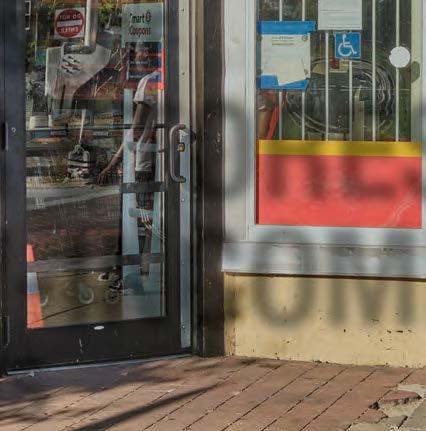

point, some say these businesses number far too many.
ey are also more likely to be owned by non-residents.
“( ose stores) take resources out of the community and don’t give us an opportunity to circulate the dollar within the community,” says Tonya Trice, executive director of the South Shore Chamber of Commerce. “ at money leaves our community as soon as it is spent.”
South Shore isn’t an exception. roughout Chicago’s South and West sides, retail corridors are heavily populated with stores that do
SPONSORS
not keep wealth in the community. So-called dollar stores are a prime example. ese variety stores sell food items in retail spaces that could be occupied by a full-service grocery store or health-conscious restaurant, say those who want to see economic improvements in disinvested areas. ese stores also leech o vulnerable, low-income customers by price gouging, activists and others say.
A lack of retail variety also forces neighborhood residents to spend their money elsewhere — a heightened concern for a commu-

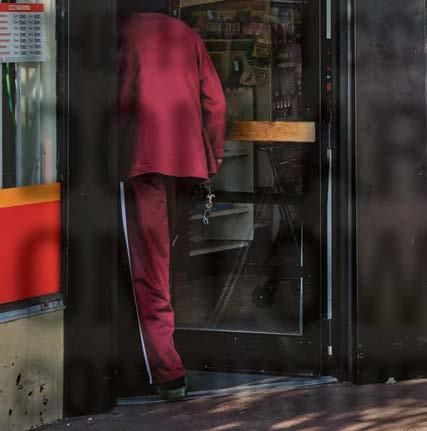
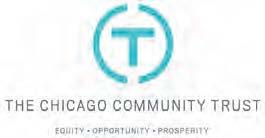
See RETAIL on Page 16

All told, $200 million worth of retail spending leaves South Shore annually, according to a 2020 city study of the corridor.The South Shore neighborhood GEOFFREY BLACK
From Page 15
nity trying to reverse decades of economic disinvestment. All told, $200 million in retail spending leaves South Shore annually, according to a 2020 city study of the corridor
Two streets, 75th and 79th, that run through South Shore were once historically signi cant retail corridors. Today, where no dollar store or other small businesses exist along East 79th Street, entire blocks are lled with empty storefronts.
e composition of retailers in a community directly a ects the health of its economy and its residents. A grocery store might stay away from an area if several dollar stores create too much competition, meaning residents have access only to the processed food items sold there. Without a grocery store, other retailers might not see the area as worth investing in, which results in lower home values and a weakened tax base. Some types of retailers that proliferate in lower-income retail corridors are so small that they cannot a ord to hire employees, contributing to even lower unemployment rates.
e roots of these limited retail options are manifold. e majority of the residents in the a ected neighborhoods are Black and low-income. Decades of segregation, discriminatory practices and racist policies perpetuated by governments and the private sector have made it di cult for Black entrepreneurs to get loans and start businesses. Latino entrepreneurs face similar issues accessing capital.
In fact, just 9% of businesses with employees in Cook County are Black- or Latino-owned, though those groups comprise 57% of the population, according to a 2021 Chicago O ce of Equity & Racial Justice report. Community development experts say the lack of local business ownership in such communities invites more outside operators.
It’s a compounding issue. When hunting for a location, retailers often look for similar businesses to gauge whether they could be successful in a certain corridor, says Brad McConnell, CEO of nonpro t Allies for Community Business, a nonpro t that provides coaching, capital and connections for entrepreneurs who have been traditionally underserved. at’s why competing fried chicken joints sometimes set up across the street from each other, or two mobile phone stores open in the same strip mall. Landlords, for their part, are looking for the most stable potential tenants, prioritizing rent collection.
“ ere’s a lot of copycatism in the absence of true market analysis,” he says. “It’s just lazy market research.”
Dollar stores are an example of the types of businesses concentrated in Chicago’s South and West
side retail corridors. A study by the Brookings Institution released in April found that chain dollar stores have targeted majority-Black urban neighborhoods, “often saturating these communities with outlets and making it more dicult for local businesses and other grocery chains to become established.”
Income levels did not matter as much: e study found that in Chicago, majority-Black neighborhoods in the top income quartile were more likely to be near a dollar store than non-majority Black neighborhoods at any income level.
Take South Shore. Its population is almost 93% Black. e community’s per capita income is $27,734, according to the Chicago Metropolitan Agency for Planning’s July 2023 data snapshot.
Along the 79th Street corridor, two Family Dollar stores and one Dollar General are within about six blocks of each other. Two more Family Dollar stores are in the neighborhood, one on 71st Street and one on Stony Island Avenue. A Dollar Tree is at 72nd Street and Stony Island.
Dollar Tree, which owns Family Dollar, and Dollar General are both publicly traded companies that count private-equity rms among their largest shareholders. Private-equity rms are known for ruthlessly squeezing e ciencies out of companies they own. But they also have money to fuel expansion, an appealing attribute as interest rates remain high. As such, private equity-owned companies have the capacity to both exploit and bring bene ts to communities, particularly by hiring local employees.
“It’s a double-edged sword,” says Andee Harris, an adjunct lecturer
of entrepreneurship at Northwestern University’s Kellogg School of Management. “Job creation is a big piece of it. . . .We can’t ignore that.” Others argue that dollar stores do ll a void in communities with few other retail options.
Craig Chico, president and CEO of the Back of the Yards Neighborhood Council, says neighborhood residents do not hate the dollar stores and shop at them regularly. Walmart closed its Back of the Yards store in 2019, so the dollar stores ll a need, he says. One dollar store also took over a long-vacant building when it opened, which reduces blight. It’s a similar story with McDonald’s. e 40,000-person neighborhood has two, which some would argue presents too many unhealthy food options.
But the restaurants are always busy, Chico says. “You can’t complain about them if people are shopping” there, he says.
ough Dollar Tree and Dollar General missed Wall Street’s expectations in their most recent quarterly earnings, both national companies grew annual pro ts and sales last year, mostly through expansion. Dollar Tree’s net income was $1.6 billion last year, up 21.7% from 2021. Sales were $28.3 billion, up 7.6% from the previous year. Dollar General’s net income was $2.4 billion, up less than 1% year-over-year. Sales were $37.8 billion, up 10.6%.
South Side residents see that growth, and dollar store pit stops are ingrained in their routines.
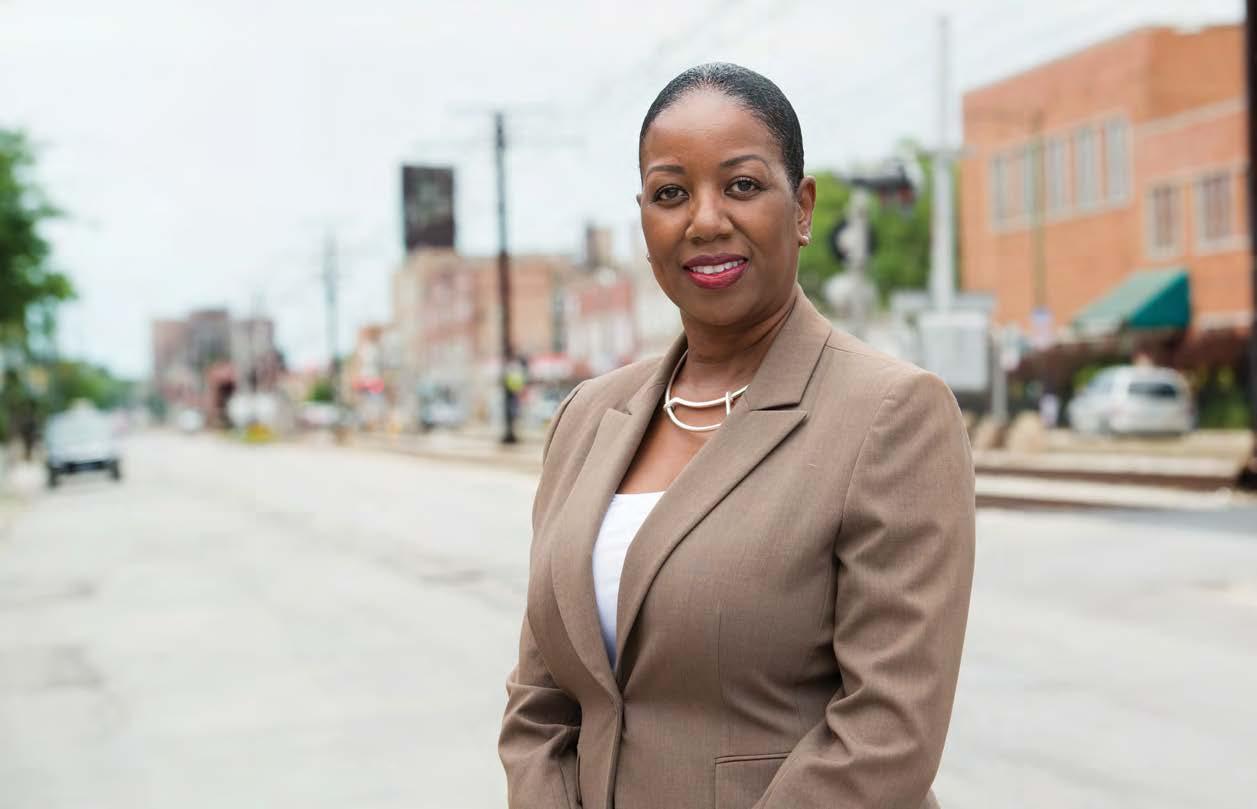
“It’s de nitely one of the more prevalent kinds of stores around here,” says Amanda Eaves, while on duty at her job at the Chicago Public Library branch in West Pullman, across the street from a Family Dollar. e 45-year-old Calumet
Heights resident says she frequents dollar stores for housing supplies, buying toiletries or grabbing a drink. “You do have CVS and Walgreens and stu , but not nearly as much as the dollar stores.”
e harm dollar stores do to a community cuts beneath the surface, argues Mari Gallagher, principal of Chicago-based Mari Gallagher Research & Consulting Group. She refers to them as “fringe” stores.
“A fringe store mostly specializes in the so-called foods that are high in salt, fat, sugar and low nutritional value,” she says. “A fringe store is the kind of store that might provide some convenience, but if it’s your primary location for getting food, chances are over time your diet, your health will su er.”
Dollar General says in a statement to Crain’s that thousands of customers in Cook County and across the country rely on it for “convenient access to a ordable household essentials.” Such access to a ordable products is one of the economic bene ts each store provides to communities, the statement says.
“We believe our purpose-driven mission of serving others and our intense customer focus di erentiate Dollar General from other seemingly similar retailers,” the statement says. We invest “in communities where other retailers cannot or will not serve.”
Dollar Tree did not respond to requests for comment.
e Brookings study released in April also found that the presence of fast-food restaurants positively correlated with the percentage of Black residents in urban neighborhoods in the U.S. Too many fried food joints creates a situation similar to too many dollar stores: e competition they create can keep
away healthier food options, harming the health of residents over the long term.
Chicken and sh
e stretch of Madison Avenue that runs through the Austin neighborhood on Chicago’s West Side is less than two miles long, but it has more than half a dozen fried chicken or sh restaurants. Such restaurants’ business models are built around paying low rent and selling cheap, commodity items like chicken and sh, says Brandon Guthrie, general partner at Dubai-based Shatranj Capital Partners, a food- and beverage-focused private-equity rm. e one-o fried food restaurants on South and West Side street corners have low pro t margins. ey are typically run by the operator to keep labor costs down and rarely hire from the community. A locally owned mom-and-pop restaurant would not be able to compete.
“Mom-and-pop restaurants need higher margins,” Guthrie says. “If your whole living is based o this restaurant, you have to make some money.”
ese kinds of extractive business models aren’t limited to retail stores or restaurants. Churches can also take money out of a community, further hurting the economic health of a neighborhood.
How does that work? Churches are exempt from paying property taxes, says Samuel Brunson, associate dean for faculty research and development at Loyola University Chicago.
“It’s not unique to churches,” he says. “Anything that’s exempt from property tax takes money out of the city co ers, and it makes other people either have to pay more, or
allows the city to provide less.”
Property and sales taxes are the primary source of revenue for Chicago. e bulk of that revenue supports the budgets for the Chicago Public Schools, the Chicago Police Department, the Chicago Park District, the Chicago Public Library, and goes toward public employee pensions funds.
Churches are also not required to le 990s, a document that outlines nancial information about tax-exempt organizations. Without such a requirement, details about where the money goes are scarce and di cult to pin down unless the church’s leadership is willing to disclose it, Brunson says.

e bulk of church nances go toward building upkeep, paying rent or a mortgage and paying musicians, says Rev. Sidney Williams, CEO of New Jersey-based investment management company Crossing Capital Group.

Churches in certain neighborhoods are often found in clusters, like along 119th Street in West Pullman. ere are more than a dozen storefront churches along that corridor between Halsted and State streets.
“You shouldn’t have a block full of faith-based organizations,” says Abraham Lacy, president of the West Pullman-based nonpro t Far South Community Development
Corp. “ ey begin to cannibalize each other.”






Churches have proliferated on Chicago’s South and West sides because they act as refuges for Black people, a role born during the Civil Rights movement. Being so highly concentrated, though, means more empty storefronts if the churches start driving each other out of business.

To help alleviate the concentration of such non-pro t structures, Lacy suggests designating areas in commercial corridors where tax-exempt properties cannot locate. Such districts could instead focus on driving innovation, and recruiting retail the community wants or needs.
e city of Chicago said in a statement that it is making investments in South and West side neighborhoods that will strengthen retail corridors and “build household and community wealth.” Under the administration of former Mayor Lori Lightfoot, the Chicago Department of Business A airs & Consumer Protection provided funding to small business owners, artists and landlords to activate commercial corridors. Developers, nonpro ts and other groups are also working to take ownership of retail corridors.
e nonpro t Far South Community Development Corp. places
local entrepreneurs into brick-andmortar locations to ease nancial burdens. e program, called Far South CDC Marketplace, is part of a broader plan to repurpose 1 million square feet of blighted areas into “anchor” developments to build community wealth and increase the population.

Likewise, Chicago TREND, a commercial real estate developer, is deploying a strategy that allows
residents to invest in commercial retail properties. A social enterprise formed in 2016, it focuses on transforming retail economics in communities of color. It owns three neighborhood shopping centers in the city and one in south suburban Olympia Fields, with plans to buy two more Chicago properties in the next year.
Chicago TREND hired local property managers and local leas-





ing agents who put equity into the properties. It identi es, acquires and improves service-oriented community shopping centers in urban neighborhoods by partnering with entrepreneurs and residents. e enterprise has deployed this model at two properties in Baltimore.
“When was the last time local people had an opportunity to own the strip center at the corner, or mixed-use property that is the front door to the commercial corridor of the neighborhood?” says Chicago TREND CEO Lyneir Richardson. “ ose individuals will patronize and protect the commercial property in a di erent way.”
South Shore, too, with its oversaturation of fried food joints, beauty shops and dollar stores, is looking to take a similar approach.
e Chamber of Commerce is set to launch a model in late 2024 that would allow residents to invest in commercial properties. Trice, of the South Shore Chamber, says allowing residents to take ownership is one of the only ways to really control which businesses open in a community.
“When you don’t control the assets, you have very little say on what can go into those storefronts,” she says. “We need control of the assets in the community.”

40%










44% OF LATINX HOUSEHOLDS
69%

Ihope Chicago’s politicians move back to investing in Chicagoans.
I’ve lived here my entire life and feel like a survivor of the corporate apocalypse of my community and the city. It’s the people, not the conglomerates, who will reinvigorate this city.
With the abrupt departure of the most recent big-box operation, Black Chicago braced for the inevitable blame for its rapid exit. Never mind the fact that retail is su ering across the country. Brush past the mathematical reality. Online business is much more lucrative than retail. e “Black people are thieves” narrative will allow mainstream Chicagoans to be accepting of this insincere departure.
Greeted as liberators, big-boxes descended on our communities offering desperately low wages, forcing new generations of Black people to shift to government subsidies. When I was young, I didn’t know anyone on government aid. My community was lled with union labor, from teachers and nurses to
boilermakers and janitors. ose who didn’t have union jobs had small businesses. e mechanics, the hair salons, the pool halls, the community centers, the restaurants and the corner stores were everywhere. e money stayed in the community, if only for a while. People worked in the community. e bigbox stores coming into the inner city were the decimators of our small businesses.
When I was young, Chicago was full of cultural communities. We would go to the West Loop corridor and get real aming cheese in Greektown. We went to Chinatown and ate authentic Chinese food in such a densely, culturally rich community that we felt like we left the continent. We got authentic Italian pasta from Little Italy and real Ethiopian food from Wrigleyville.
When we were really fancy, we had ne dining downtown. I remember my grandmother letting me order “clams casino” from Arnie’s. While the South side ruled soul food, I
never felt unwelcome in Chicago. We were Chicagoans, period. Fast-forward to the new narrative, “segregation” is the problem. We had that mayor who decided that closing our schools and overpolicing our children was a start. He then had savior-missioned nonpro ts entice corporations to put warehouse facilities with grunge-labor, soul-crushing jobs in our once-beautiful neighborhoods. He would then gentrify the other Black communities. e city lost over 250,000 residents who didn’t want to live in pre-apocalypse Black Chicago.
Chicago used to be in the top ve places that a Black person should start a business. Now, it’s not in anyone’s Top 20 list. e designat-
ed “Black leaders” elevated only themselves. Most of them cannot identify three people who they’ve in uenced or even helped, let alone one community. To be independently upwardly mobile, you had to leave Chicago. e best you could aim for here was the “minority partner,” good for photographs, a few dollars and little else.
But those of us who stayed here decided the last mayoral race was our last chance. Some of us remember when Chicago was not about pitting this Chicagoan against that Chicagoan so that rich people could get richer. We got together and got back to basics. We elected an ordinary man to be mayor. I’m hoping he routes our tax dollars back into all of our commu-
Chicago’s neighborhoods are known worldwide for their grand architectural heritage — rows of stately twoats and greystones, broad, tree-lined parkways, courtyard apartments, craftsman bungalows and vibrant commercial corridors.
Amid this beauty is another familiar yet humbler sight: strip malls. While many provide essential community amenities, others are poorly maintained, partially vacant or home to businesses like liquor stores or predatory lenders that undermine neighborhood strength.

What if we were more intentional in harnessing the potential of these familiar sites to create community assets? What if this type of overlooked real estate could improve access to healthy food and needed retail? What if the properties themselves could be a vehicle to build wealth for nearby residents?
Chicago TREND is taking an exciting rst step toward this vision through a new real estate fund.
Led by entrepreneur Lyneir Richardson, Chicago TREND will leverage impact investment capital to buy overlooked commercial centers in underserved communities. It will then partner with entrepreneurs of color to upgrade the properties and improve each center’s retail o erings to meet community needs. Most exciting, an innovative crowdfunding structure will enable nearby residents to participate in each purchase for as little as $1,000 and bene t from future appreciation.
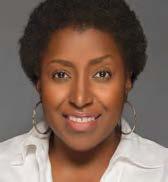
is comprehensive approach can turn everyday strip malls into drivers of community change — improving access to quality retail like restaurants and pharmacies, turning eyesore properties into community assets and creating pathways for nearby residents to

generate wealth.
e Pritzker Traubert Foundation believes that Chicago succeeds when its residents live in strong, supportive and vibrant neighborhoods. We are partners with the Kresge Foundation, the MacArthur Foundation, the McKnight Foundation, the Surdna Foundation and others to
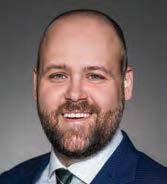
launch Chicago TREND, which we believe is an important step toward this goal.
But make no mistake: ere is much more to do. is work is complex and not without risk.
Closing the racial wealth gap will require collaboration, creativity and commitment to unraveling decades of disinvestment.
nities. I hope the City Council understands that the tiny cultural community of Little Havana in Miami brings almost $20 million in tourism revenue to Miami because people want cultural experiences when they travel. I hope they realize that our Bronzeville community was once wealthier than Harlem. I hope we can see a resurgence of vibrant cultural communities of people who speak multiple languages and sell interesting wares. I hope they realize that the exact same co ee shop every four blocks is not something to brag about. Help cultural spaces owned by multi-cultural Chicagoans return to the city. As a great Chicago politician once said, “We are the change we are looking for.”
Others are needed to help Chicago TREND grow its resources to take this work to scale, to expand the availability of exible capital to more visionary entrepreneurs like Lyneir and to think more creatively and collaboratively about how to tap all of what makes Chicago great — grand and humble alike — to strengthen our neighborhoods.
Rex Ingram opened a UPS Store in Woodlawn four years ago, knowing the community needed it. He didn’t expect the 63rd Street storefront to become such a draw.
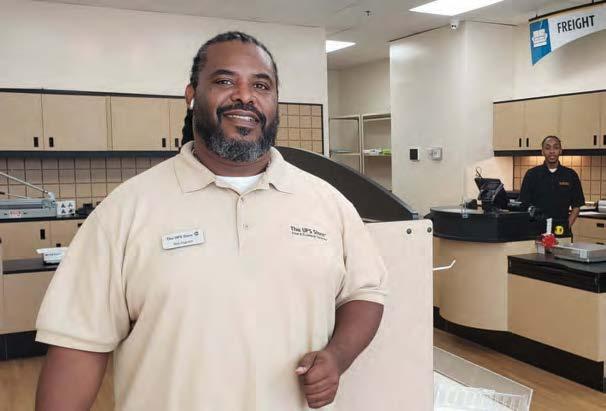
Customers regularly cross Interstate 90 to come from nearby Chatham and Calumet Heights to patronize the franchise. Woodlawn residents, of course, have been loyal, too.
“ ey needed the mailbox services immensely. ey needed the shipping services immensely,” Ingram says. “All the things we do as a UPS store, they didn’t have it in the Woodlawn community.”
Ingram and his wife, Monica — Auburn Gresham residents who have gone to church in Woodlawn for 20 years — opened the franchise with help from a low-interest loan from Chicago TREND. e social enterprise, which started in 2016, provides capital to entrepreneurs and buys commercial properties on the South and West sides with the goal of getting more locally owned businesses into those communities and building wealth there.
e work is part of a broader movement among chambers of commerce and other local groups to take control of strip malls and com-
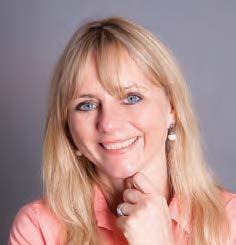
mercial properties in Chicago’s lower-income neighborhoods. From South Shore to West Pullman, community members are fed up with the proliferation of fast-food joints, beauty salons and so-called dollar stores. ey want more locally owned businesses to provide services they need — like a UPS Store — and they want to spend their money at stores that will keep those dollars in the neighborhood.
To change the pattern, commercial developers like Chicago TREND must rethink typical capital lending and real estate models.
“ e community often complains . . . ‘Do we only have to have fastfood and dollar stores and check-cashing and liquor stores and cellphone stores?’” says Lyneir Richardson, CEO of Chicago TREND. “If those businesses found a way to create an operating model that can be pro table in low- and moderate-income neighborhoods, why aren’t there others? at’s the question we’re trying to solve.”
TREND’s help Chicago TREND provides capital for local entrepreneurs, like Ingram, and o ers rent abatements for its tenants. It also helps with technical assistance, such as store buildouts and connecting entre-

preneurs to franchises. In 2020, it started selling some equity in the buildings it owns to the entrepreneurs who run businesses there and to the local property managers and leasing agents it works with.
e next step is to allow neighborhood residents with as little as $1,000 to invest in the property.
Chicago TREND owns properties in the South Loop and Chatham, and it co-owns the Woodlawn property where Ingram’s UPS Store is located. It also owns a property in south suburban Olympia Fields.
e hope is that attracting local ownership could spur more intentional leasing and recruit services needed to make a community successful, Richardson says. If residents own part of a strip mall, they will have pride in it and shop there more. If leasing agents are local, they will seek out tenants that ll a need, instead of just another friedsh place, because they know it will pay rent. And if local entrepreneurs own a business there, they will give back to the community and keep dollars local.
Bronzeville resident Tracy Powell opened a co ee shop in Chicago TREND’s South Loop building, at 2119 S. State St. His business, Momentum Co ee, also has locations in Millennium Park, Englewood,
Lawndale and Austin. At each location, he has some partnership with the landlord — one paid to build out the kitchen, one o ers rent abatement, and he got a low-interest loan from Chicago TREND.
ose partnerships have helped Momentum Co ee become economically viable, Powell says. In turn, the co ee shop plays host to a variety of community-oriented gatherings. It o ers free coding programs for youth, lets the American Cancer Society give lectures in its space, and hosts poetry readings.
Having partners that approach leasing and lending in a di erent way has been vital, Powell says. It takes time for the community members to get used to a new business in a disinvested corridor.
“When you go into neighborhoods that have undergone all this, you need partnerships in order to survive,” he says. “People have developed certain habits. Once you’ve gone 30 years without a store in XYZ location, it takes them years to even see you. . . .We’ve learned to be very patient.”
Maybe you heard about the two economists walking down the street, one asking skeptically, as they both keep walking: “Isn’t that a hundred-dollar bill that someone dropped on the sidewalk? e quick reply: “No, because if that was a hundred-dol lar bill, someone would have picked it up al ready.”
at reminds me of another recurring story, sad but true, about the lack of quality retail, particularly grocery stores, on Chicago’s West, South, and Far South sides. Why is this so? Some readers would instantly say the local economy. Translation: Not enough hundred-dollar bills lying around because, if there were, the market would naturally respond, and quality grocery and other retailers would exist there already.
But that’s not how local markets work. Retail attracts retail, and like attracts like, in either a positive or negative direction. e conundrum is that quality retail typically goes where quality retail is already. With a more careful and granular data analysis, we see that there are way more hundred-dollar bills than imagined. Not everyone is poor where retail choices are lacking.
In 2006, our rm released “Exam-
ining the Impact of Food Deserts on Public Health in Chicago.” E orts in Chicago and across Illinois enjoyed some short-term success in opening needed stores. But over time, many communities su ered severe and disappointing setbacks, with newly built, subsidized stores closing while other areas were unable to recruit any quality food stores at all.
We and many others have always stressed that plopping down a grocery store and cutting the ribbon in front of the cameras does not mean the problem is solved. In fact, over the long run, opening stores without a sustainable plan does more harm than good. We could pin these failures on the “local economy,” but that would be disingenuous. Markets are complicated.
So are people and their food choices. People just want at least the basics of living and shopping like everyone else.
Consider the communities of Englewood and West Englewood.
Everyone knows that the Whole Foods store closed, but are you aware there are currently 55 other authorized “food” retailers participating in the Supplemental Nutrition Assistance Program as the rst line of defense against malnutrition? ink gas stations, dollar
stores and liquor stores. e highest level of retail sets the tone, and the overall tone sends a signal to the marketplace that can attract certain retailers and repel others. Shoppers are also a ected.
Recently while visiting a dollar store in Roseland, I observed rsthand spoiled food products in coolers and freezers that clearly pose health and safety risks. I’m talking about gallons of milk with congealed and lumpy clusters clearly visible and “frozen” vegetables that were partially thawed and dripping. e shelf-stable “food” products were mostly items high in salt, fat, sugar and calories, such as chips, soda and candy. Some shelves were bare. In other cases, product was left in boxes in the aisles for customers to pick through
and zigzag around. When I pointed out the spoiled product to employees, they shook their heads and stated that several coolers and freezers had been malfunctioning for over three months, which hurts them, too, as they live nearby and have limited shopping options.
When a chain grocery store has spoiled or inferior product, it makes headlines and generates protests, and it should. But why do other retailers like dollar stores seem to get a pass? ese substandard retailers have been ignoring the rules and dragging communities down for decades. It is extremely hard for genuine grocers to compete in these environments. Yet we expect a single, incentivized store to come in and x things. It’s a job that even the best grocers aren’t good at, don’t want
and won’t do.
Time for a new game plan.
Mayor Brandon Johnson’s administration should consider a few municipally owned or nonpro t grocery options and a community engagement e ort that uses existing carrots and sticks to set a new commercial tone that, over time, other retailers match. Some local independent food stores aspire to step up, but they don’t have the purchasing power of dollar and convenience store chains. Why not help them with a collective purchasing initiative? Good grocers go where good grocers are already, and they, in turn, will attract other types of quality stores that people want and need. Leading by example will begin the long, hard work of market repair.
new leadership can help.
“ e ‘mutually agreed’ departure probably comes from the fact that the ramp up of the U.S. health care business was slower than expected to pro tability,” says Keonhee Kim, an industry analyst at Chicago-based Morningstar.
Initial lackluster results from the health care segment, coupled with Walgreens’ pharmacy and retail segments lagging, too, have contributed to a steadily declining stock price, with much of the decrease taking place during Brewer’s tenure. Since she took the helm in March 2021, Walgreens’ stock has declined 55% and the company’s market capitalization is down to less than $21 billion.

With Brewer gone, Walgreens is at an in ection point. e company needs to replace her with the right talent, as well as nd a permanent chief nancial o cer — a role vacated in July. Both newcomers will be tasked with getting the company back on a path that clears the way for long-term sustainability and appeases investors, including one of the company’s largest individual shareholders: Executive Chairman Stefano Pessina, who holds a roughly 17% stake.
“Walgreens needs to hire somebody with a deep knowledge of the health care business,” says Dr. Joel Shalowitz, a professor of preventive medicine at Northwestern University’s Feinberg School of Medicine.
In the meantime, lacking two permanent key executives could make investors uneasy about Walgreens’ direction, putting the stock price at risk for further deterioration. e news of Brewer’s departure sent Walgreens’ stock tumbling 7% on Sept. 1 to the $24 range. Shares declined further and were trading around $22 late last week.
Kim, the Morningstar analyst, says the immediate stock price decline re ected “unsettled investor sentiments” toward Walgreens. He adds that Walgreens’ Sept. 1 disclosure that its full-year 2023 adjusted earnings per share will be at or near the low end of its previously stated range of $4 to $4.05 a share was also dampening the stock price.
“Given those two statements, investors probably felt a little bit unsafe with Walgreens,” Kim says. Walgreens declined to comment for this story.
Tens of billions invested
Over the past several years, Walgreens has invested tens of billions of dollars to support its health care strategy. e company paid $6 billion for a majority stake in VillageMD and an additional $6.5 billion to buy postacute and home care rm CareCentrix and specialty pharmacy Shields Health Solutions and to nance VillageMD’s acquisition of primary care company Summit Health-CityMD. Walgreens has also sold more than $4 billion worth of its AmerisourceBergen stock, in part to fund the strategy.
All those moves combined indicate it’s likely too late for Walgreens to turn back.
“I would think that Walgreens is at least going to try to make this work,” Kim says. “ ey’ve already spent billions of dollars on opening up this new channel for future growth.”
Walgreens executives have previously said they projected the U.S. Healthcare segment becoming pro table in 2024. ey also set an ambitious goal to open VillageMD clinics in 1,000 stores by 2027, but in June, John
Driscoll, executive vice president and president of Walgreens’ health care segment, said the company is slowing the pace of clinic openings.
“While we’re con dent in the range and scale of our health care business, we are disappointed with the pace of our path to profitability,” he told investors on an earnings call at the time. “We anticipate this year will remain a transition year as we take action to deliver value and drive pro tability.”
e segment’s revenue in the third quarter grew 42% to $2 bil-
lion compared to the same time period a year ago but still posted an operating loss of $522 million, according to a June press release.
Ultimately, Walgreens’ chances of nding success with the heath segment and its broader business depend on its next CEO.
“We’re only going to know when we nd out who the next CEO is going to be,” says Shalowitz of Northwestern’s Feinberg school. “ at’s going to send a very big message about which direction the company is going.”
With a Federal Deposit Insurance Corp. consent order on the way, Discover Financial Services has named a retired FDIC o cial to its board to help bolster its compliance performance.
Kathy “Moe” Lonowski, who spent a 38-year career with the FDIC and retired recently as regional director of the agency’s San Francisco region, brings the board of the Riverwoods-based credit-card company to 13 members.
Since 2016, Lonowski had
overseen the San Francisco region, the FDIC’s largest in terms of gross domestic product, covering 11 western states. She joins the Discover board’s risk oversight committee.
“With compliance being a top priority at Discover, Kathy’s expertise with regulatory issues and understanding of the nancial services industry will help make the company more e ective in managing risk,” Discover Chairman Tom Maheras said in a press release.
Discover is searching for a new CEO after pushing out Roger
Hochschild, a 25-year company veteran, last month. Hochschild had taken responsibility for a series of compliance-related problems, saying the company had “underinvested” in personnel and systems dedicated to following rules and regulations.
e company disclosed in July that it was reviewing a proposed FDIC consent order “in connection with consumer compliance.” It’s operating under a separate 2020 consent order with another federal regulator, the Consumer Financial Protection Bureau.
“Walgreens needs to hire somebody with a deep knowledge of the health care business.”Dr. Joel Shalowitz, a professor of preventive medicine at Northwestern University’s Feinberg School of Medicine Steve Daniels



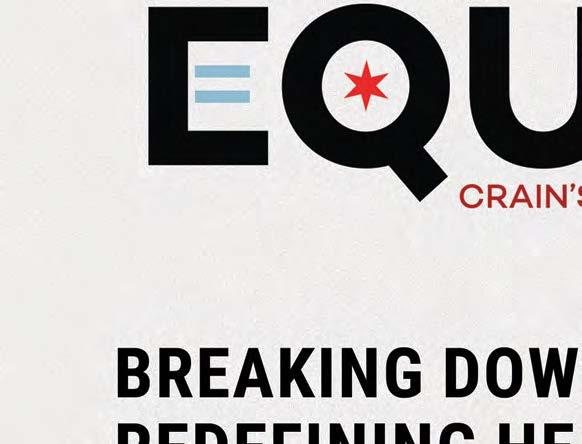



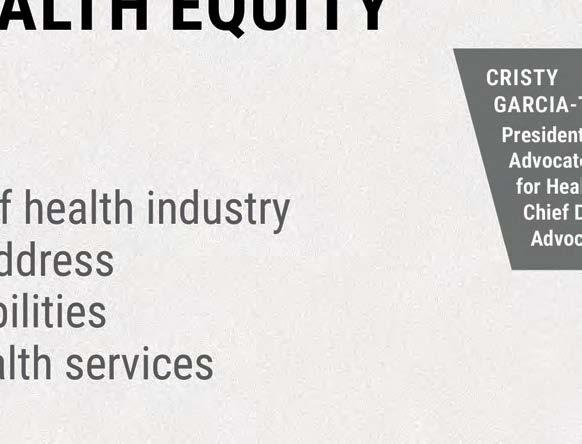






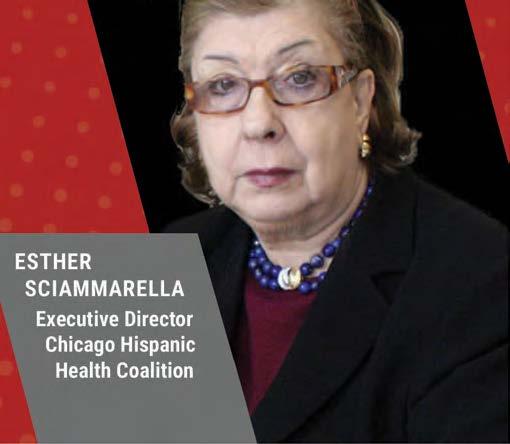
e shell of the combination 425car parking garage and Chicago Public Library branch is done, all to be topped with a landscaped green roof. e center’s central tower, which will house a digital presidential library and museum lled with memorabilia from Barack and Michelle Obama’s lives and time in Washington, is now several stories in the air and set to be topped o by April.
Overall, the center’s CEO, Valerie Jarrett, says after a tour of the site that construction of the $800 million facility is about halfway done and due to be completed by fall 2025.

“I could not be more happy with the progress we’ve been making,” says Jarrett, who has known the Obamas for decades and served as senior adviser to former President Obama for the eight years of his presidency.
When the facility is done, Jarrett expects the rst couple to be here “as often as possible” — and certainly as often as the every month or so they come here from Washington or Hawaii, where they tend to hang out in the winter. “ ey selected the location for the center because they consider (Chicago) to be their home,” she says.
During the tour, Lori Healey, executive vice president of the sponsoring Obama Foundation and executive project manager of the construction job, emphasized particular points about the construction process. Like the extensive greenery, with artists’ renditions depicting an iconic obelisk of sorts surrounded by trees, a great lawn, and a fruit and vegetable garden. Or the focus on hiring minority contractors and workers to build the monument and continuing education center honoring the nation’s rst Black president. Healey also notes a new,
From Page 1
e question is whether it’s politically feasible. To list just one impediment: Gov. J.B. Pritzker has given no sign that he’s prepared to back o his opposition to widening the sales tax to cover more services, though the plan suggests that the overall sales tax rate could be lowered somewhat in exchange for a wider base.
e plan comes from a working group of lawmakers, transit ocials and civic leaders assembled by the Chicago Metropolitan Agency for Planning. ough technically still a draft that is to be formally considered by CMAP’s board this week, it already has been heavily vetted and major changes are not needed.
Driving the proposed Plan for Action for Regional Transit, or PART, is an unavoidable scal reality: With work and commuting patterns having changed dramatically since COVID hit, area transit operators are carrying only about 40% as many passengers on week-
already-open athletic center on the edge of the site, one that will make up for athletic elds that were removed during the construction process.
All of that is a nod to elements of the surrounding community
days compared to pre-pandemic, with ridership expected to hit only the 68% level by 2026. With federal COVID relief funds due to dry up after 2025, that leaves the three operating agencies and the supervisory Regional Transportation Authority with a budget hole of at least $730 million in 2026, rising to $1.2 billion by 2031, if no changes are made.
Because the agencies generally have to run balanced budgets, shortfalls of that magnitude likely would force service cuts by 35% to 40%.
“Transit helps the region to achieve its goal to become a more inclusive, prosperous, and equitable place to live, work, and thrive,” the report says. “ e challenges facing northeastern Illinois’ transit system are signi cant; so too are the risks the region faces from the scale of cuts inaction would require.”
“Less frequent and reliable service can leave riders feeling unsafe while waiting for transit,” the report says. “Residents who are rid-
who have objected to giving up park space, even for the Obamas, and who have pushed hard for a written agreement guaranteeing certain things will be done for them, such as steps to prevent gentri cation of the surrounding
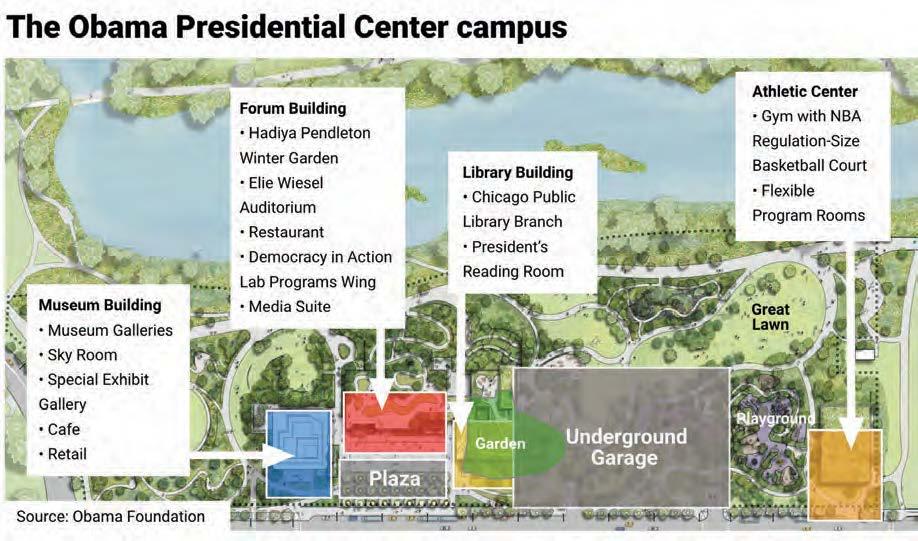
ing less often may decide to stop using the system entirely due to frustrations with reliability. Potential new transit employees may be dissuaded from applying due to safety concerns. Collectively, these challenges and others have left the system at risk of a downward spiral — with fewer riders, service cuts and a region that is less connected.”
To deal with that, the plan mostly proposes scal xes — and some enhancement in service, particularly buses and regional rail, that would cost money but boost ridership. At least one tweak, though, could bene t almost all riders: enacting a monthly spending cap in which computers could keep track of how often a rider used transit and ensure that their total expenditure did not exceed the cost of a monthly pass, even if they didn’t buy one.
Getting the warmest treatment is an idea that has been kicked around in Illinois politics for decades but never gained much political traction: following the lead of numerous other states and widening the sales tax to
Rising property values are not necessarily a bad thing, she continues, suggesting that local homes owned by Black residents will help them build wealth if the center raises their value. e center owes a responsibility to “the broader community,” one it will serve by helping people learn how the Obamas succeeded and hopefully helping visitors succeed, too, she says.
One thing that’s apparently o the table: rebuilding nearby Jackson Park golf courses into one professional-level facility — one t for a PGA tournament or a golf-loving ex-president. e Obama Foundation and center are not pursuing that, says Jarrett, adding that she’s heard only “rumors” that someone might like to revive the idea, which was rst oated several years ago.
Jarrett does have more to say about the museum and library. Except for special events and shows, only digital copies will be available here, with the original documents kept elsewhere. e museum will have originals, such as some of Michelle Obama’s dresses, and include a replica of the Oval O ce. Its director will be Louise Bernard, a specialist in African American history who has worked on projects for the Smithsonian Institution, Yale University and the New York Public Library.
And fundraising? So far, roughly $1.3 billion is in hand. e center wants another $1 billion on top of that, enough to create an endowment su cient to main the center and a wide variety of programming.
neighborhood.
Jarrett makes it clear a written agreement with the neighborhood is not in the cards. “We have a nal agreement — with the city,” she says. “We put all of our commitments into that.”
cover not only purchases of hard goods, but also legal, accounting, recreational, cosmetic and other services.
Doing that along with related steps would bring in about $410 million, the report says. e state also should boost its aid, and ocials should consider tapping higher tolls and imposing a tax on downtown parking.
e report acknowledges but is restrained on security. It does call for using “transit ambassadors,” or social workers that have been hired by other cities, but does not mention an increased police presence.
It strongly urges that regional transit become more of just that, regional. e CTA and Metra could become operating units under the RTA, or merely lose much of their autonomy on budgets, hiring and other matters, the report says. Either way, o cials need to deal with today’s world by creating a uni ed fare structure and shifting some service to o -hours and new parts of the region.
e overall goal: “More frequent service at more times and in more
“I grew up just a couple of miles from here,” Jarrett says. To see a development of this magnitude on the South Side, rather than up north or downtown, is “heart-warming.”
Overall, she concludes, “ is will be a story-telling endeavor. Hopefully when people leave, they will be inspired to change.”
places throughout the region,” with train station cleaning and maintenance also being a priority.
The PART report does include some data that conservatives may seize upon to oppose more taxes and spending. For instance, the transit systems were losing riders even before COVID hit, and only 5% of whites, still a majority of the Chicago region, list public transit as their top mode of transport.
On the other hand, the report estimates the cost of owning and operating an automobile at $8,000 a year, compared to just $1,560 for unlimited rides annually on CTA, Metra and Pace combined.
Some of this already has been discussed informally with Springeld leaders. CMAP prepared the plan at the speci c direction of the General Assembly. Two lawmakers, state Sen. Ram Villivalam and state Rep. Eva-Dina Delgado, both Chicago Democrats, are expected to sponsor any legislation that comes out of PART, likely next year.
index, or by 5%, whichever is less — a policy that Lightfoot scrapped last year amid her bid for re-election and which Johnson has promised to undo.
If Johnson were to keep the policy in place, it could bring in roughly $85 million in additional revenue beyond the $1.7 billion 2023 property tax levy, because the CPI increase from December 2021 to December 2022 exceeded the 5% cap.
But increasing property taxes during Johnson’s first year after pledging to not tap that well would be a tough sell.
“I don’t think that anyone ever has a robust appetite for raising taxes,” said Ald. Jason Ervin, 28th, who is Johnson’s chosen chair of the Budget Committee.
“I think it’s very hard to say ‘I’m not going to raise property taxes’ and then four or five months later raise property taxes,” said Ald. Daniel La Spata, 1st, another Johnson ally.
The mayor’s office did not directly respond to questions for this story and instead issued a statement.
“The city’s budget office is currently in the process of developing the 2024 budget forecast, which will provide information on the city’s current financial health and resources for the upcoming budget,” the statement said. “Decisions regarding investments to be made in the 2024 budget will be released in conjunction with the mayor’s budget intro scheduled for mid-October.”
Sarah Wetmore, acting president of the Civic Federation, a fiscal watchdog, said Johnson’s first budget will be a “big indicator” of where the mayor’s priorities lie the next four years.
But, like mayors before him, Johnson’s team will learn much of the city’s budget is set in stone.
“About 20% of the budget goes to pensions, more than 20% of
shrinks further.
Johnson campaigned on raising $800 million in new revenue, but many of those options rely on Springfield action and will not be available until next year, if ever.
The mayor and his allies in the City Council have begun the process of increasing the city’s real estate transfer tax on high-end property through a tiered system that would cut the one-time tax on sales under $1 million, while gradually increasing the tax as sale prices rise, reaching a proposed 3% tax imposed on the value of property sold for over $1.5 million, which will hit commercial properties the hardest.
Even if approved through a referendum next March, the money mined from the tax won’t begin flowing to the city in time to be incorporated into Johnson’s first budget.
The new mayor has not made a public push for other business taxes since taking office. When his transition report was released in July, it was silent on whether he should push for a corporate head tax, a tax on jet fuel or a financial transaction tax, instead advocating for him to create a “more equitable” tax system without getting into the details.
the types of things that I’m looking for from this administration are the kinds of changes that you may not see right away.”
Johnson will also have to contend with the city’s rising pension costs.
Under Lightfoot, the city began to climb the pension ramp set by a state statute that mandates that two of the city’s woefully underfunded pension systems reach a 90% funded ratio by 2055, with the other two reaching the benchmark in 2058.
The city began funding the pensions according to the actuarial projections of what was needed to reach the 90% funded ratio last year, but future years will not see the large year-toyear increases that Lightfoot faced.
Wetmore said the 2024 statutory increase is projected to be around $50 million, less than what Johnson could bring in if he left in place the inflation-based property tax increase.
ChicagoBusiness.com
President and CEO KC Crain
Group publisher Jim Kirk, (312) 397-5503 or jkirk@crain.com
Editor Ann Dwyer
Managing editor Aly Brumback
Creative director Thomas J. Linden
Director of audience and engagement
Elizabeth Couch
Assistant managing editor/enterprise Joe Cahill
Assistant managing editor/special projects
Ann R. Weiler
Assistant managing editor/news features
Cassandra West
Deputy digital editor Robert Garcia
Associate creative director Karen Freese Zane
Digital design editor Jason McGregor
Art directors
Kayla Byler, Carolyn McClain, Joanna Metzger
Senior digital news designer Stephanie Swearngin
Copy chief Scott Williams
Copy editors
Todd J. Behme,Beth Jachman,Tanya Meyer
Political columnist Greg Hinz
Notables coordinator Ashley Maahs Newsroom (312) 649-5200 or editor@chicagobusiness.com
SENIOR REPORTERS
La Spata instead anticipates Johnson will declare a large surplus from the city’s tax increment financing districts to help close the budget gap without turning to property taxes. If not raising property taxes results in less money to spend on new social programs, La Spata said the progressive movement can live with that.
“Everyone who’s paying close attention knows the revenue that it takes to make transformative investments is probably the kind of thing that comes in year two, three and four,” he said. “So the question is more: ‘How do we
From Page 3
growth of Chicago’s Asian American community, which the 2020 census showed to be the fastest-growing racial or ethnic group in the city. Fueled by the proliferation of the local Chinese American population, symbols of the community have expanded well beyond Chinatown over the past decade into neighborhoods like Bridgeport, Armour Square and Douglas.
“ e (Asian American-Paci c Islander) community is the fastest-growing population, especially along the I-55 corridor, and the data continues to show us that more and more members of our communities in Chicago and the surrounding areas need more access to support and services,”
CASL Vice President of Advancement Brandi Adams said in a statement. e agency provides English-language classes, job training and other services for Chinese American immigrants.
the budget goes to pay for debt service,” she said. “Then you put in . . . salaries, which are largely determined in collective bargaining . . . then the amount of wiggle room does become smaller, because there’s only so much money left over after you fund these things that have requirements attached to them.”
Add to that the $1.9 billion Chicago Police Department budget, which Johnson said during his campaign he would not take “one cent” from, as well as millions more for the city’s ongoing response to a wave of migrant arrivals, and the wiggle room
CASL paid all cash to acquire the property from Soho Investments, a St. Louis-based venture that acquired an option for $1 million in 2008 to buy the site from Peoples Gas. e venture did not purchase it until environmental cleanup was done in 2021, when it paid just more than $3.7 million, according to ACO Commercial.
Adams said CASL pursued the purchase and development plan after receiving a “generous gift” from the Sue Ling Gin Foundation, the philanthropic trust of the late Chicago businesswoman and Flying Food Group founder. e foundation’s leaders “expressed that they wanted to make a lasting, signi cant contribution that would serve as a catalyst for CASL’s growth,” Adams said in her statement. She declined to share the estimated cost of the development plan, which she noted is still not nalized and will likely take “multiple years” to complete.
“It is very important to CASL that we gather the proper data and community feedback to ensure that what CASL builds on that
Johnson’s allies concede it’s unlikely he dramatically changes the city’s revenue streams this fall, which tracks with his thusfar cautious approach to government, preferring to score runs through small ball, singles and bunts, rather than swinging for the fences.
Ald. Maria Hadden, 49th, a Johnson ally who co-chairs the Progressive Caucus, said Johnson has “a lot of long-term strategies” to push his agenda over his four-year term.
“I’m not as concerned about whether immediate investments are going to be able to be made in the first year, in the first budget,” she said. “Because I think
property will add value and uplift all in the area,” Adams said in the statement.
CASL serves more than 6,000 clients today, according to Adams. e agency reported $19.7 million in revenue in 2021, its most recent tax documents show.
e Bridgeport site is zoned today for light industrial, meaning CASL would need the City Council to sign o on its planned development.
Helping the group’s cause is that it has a letter of support from Ald. Nicole Lee, 11th, who wrote in January of her backing of a community care campus concept on the property that would “represent the largest, most comprehensive development for a social service agency in Chicago,” according to a copy of the letter reviewed by Crain’s.
e sale came roughly a year after U.S. Sen. Dick Durbin, D-Ill., announced $1 million in federal funding to help with the restoration and conservation of Bubbly
Through an executive order Lightfoot signed in her final days of office, the city would be required to use projected revenue surpluses from 2022 and 2023 to make supplemental payments into the pension funds, following up on the $242 million advance payment Lightfoot made as part of the 2023 budget.
An aide to Johnson said the mayor may undo that executive order, but he has yet to do so.
Wetmore said that advance pension payments is a “solid way” to use the surplus, but added “there are other ways you can sustainably spend one-time revenue sources,” including shoring up the city’s rainy day fund or one-time capital expenses.
But she cautioned against using the surplus on social programs — like extending Lightfoot’s $31 million basic income pilot — unless they have a sunset clause baked into the spending, to avoid creating potentially popular, ongoing programs that don’t have a funding source.
Creek. e waterway’s name is tied to its history as a dumping ground for animal carcasses from the nearby Union Stock Yards, which have been closed for more than 50 years. As animal remains broke down, bubbles would surface on the water.
e river has been cleaned up and drawn back new wildlife over the years, and the federal money is backing an e ort by the Shedd Aquarium and Chicago Park District to restore Bubbly Creek as an aquatic resource and nature outlet.
A developer that built the Bridgeport Village residential area just south of the Pitney Court site originally had the option to buy it and was expected to pursue another residential project. But the development rm led for Chapter 11 bankruptcy protection in 2007, and the option was ultimately sold in a bankruptcy auction to the family that controls Soho Investments.
George Toscas and Linda Hattar of ACO Commercial marketed the Pitney Court property for sale.
Steve Daniels, Ally Marotti, John Pletz, Dennis Rodkin
REPORTERS
Katherine Davis, Brandon Dupré, Danny Ecker, Leigh Giangreco, Jack Grieve, Corli Jay, Justin Laurence, Steven R. Strahler
Researcher Sophie H. Rodgers
ADVERTISING
Senior vice president of sales Susan Jacobs (312) 649-5492 or susan.jacobs@crain.com
Sales director Sarah Chow (312) 280-3172 or schow@crain.com
Events manager/account executive
Christine Rozmanich
Events specialist Kaari Kafer
Account executives
Linda Gamber, Claudia Hippel, Menia Pappas, Bridget Sevcik, Laura Warren
Sales administration manager Brittany Brown
People on the Move manager Debora Stein
Classi ed sales Suzanne Janik, (313) 446-0455 or sjanik@crain.com
Inside sales Isabel Foster
CRAIN’S CONTENT STUDIO
Senior director of Crain’s Content Studio Kristin Bull, (313) 446-1608 or kbull@crain.com
Crain’s Content Studio manager Jordan Dziura
Custom content coordinator Allison Russotto
PRODUCTION
Vice president, product Kevin Skaggs
Product manager Tim Simpson
Digital designer Christine Balch
Production manager David Adair CUSTOMER SERVICE (887) 812-1590
Crain’s Chicago Business is published by Crain Communications Inc.
Chairman Keith E. Crain
Vice chairman Mary Kay Crain
President and CEO KC Crain
Senior executive VP Chris Crain
Chief Financial Of cer Robert Recchia
G.D. Crain Jr. Founder (1885-1973)
Mrs. G.D. Crain Jr. Chairman (1911-1996)
Editorial & Business Of ces
130 E Randolph St., Suite 3200, Chicago, IL 60601 (312) 649-5200
Johnson campaigned on raising $800 million in new revenue, but many of those options rely on Spring eld action and will not be available until next year, if ever.
